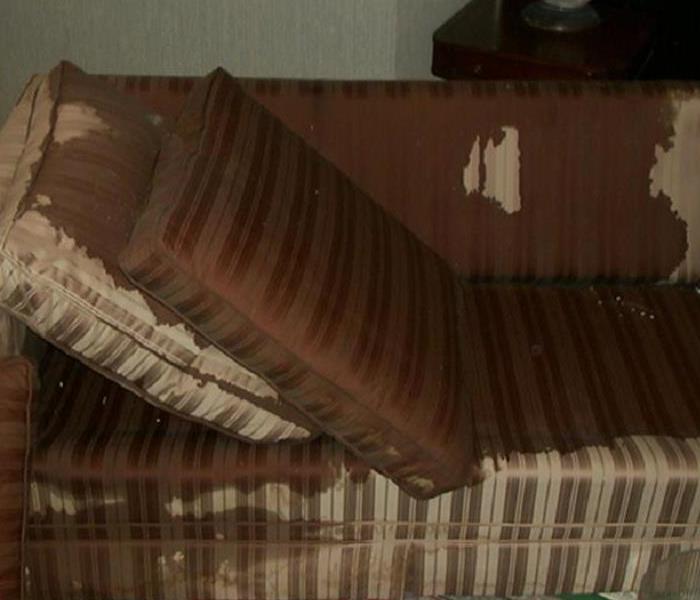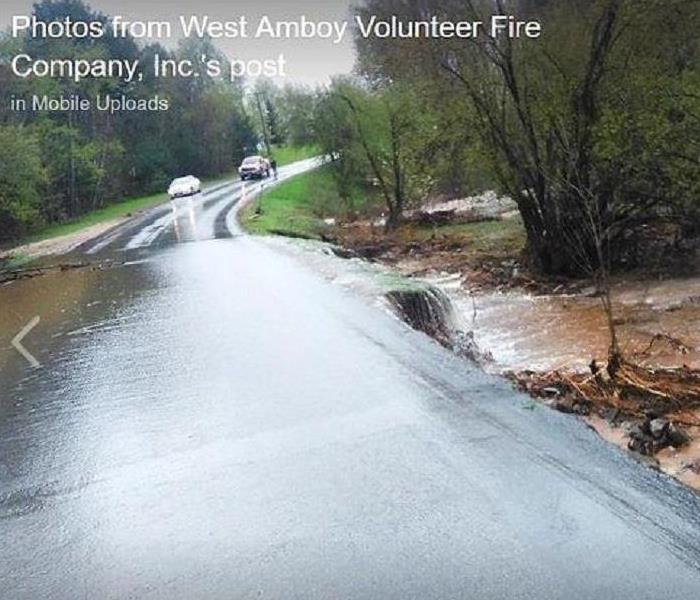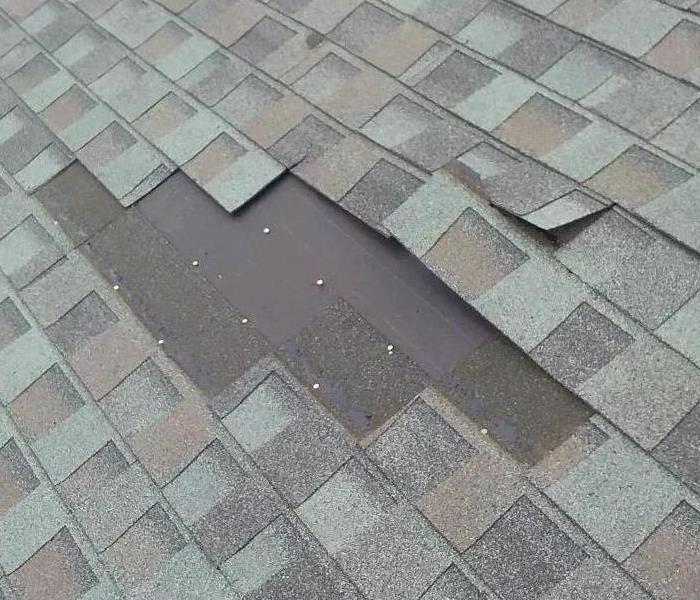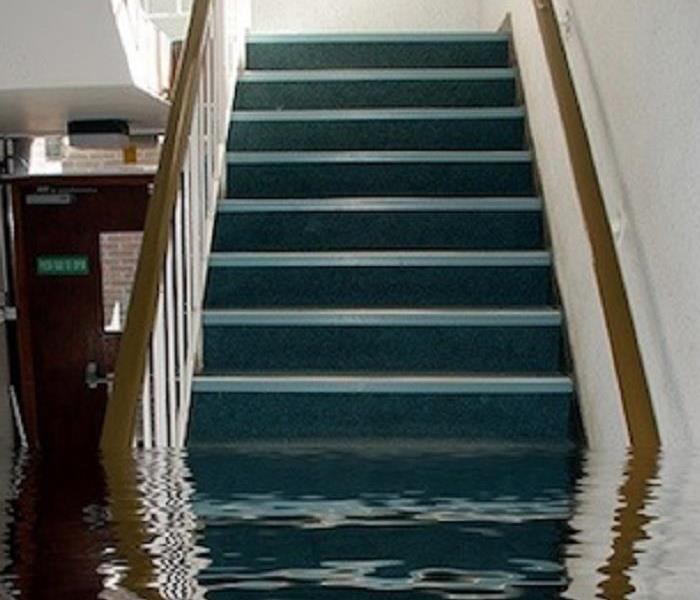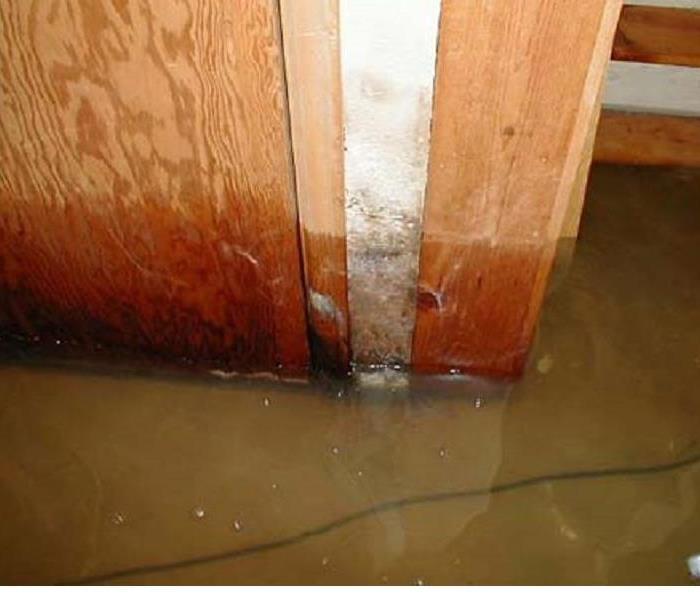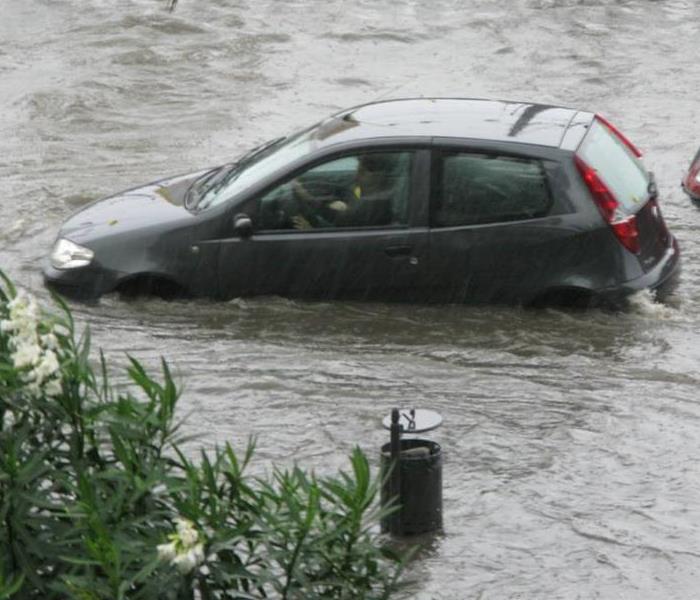Recent Water Damage Posts
Water Damage Restoration Happens Fast in Syracuse with SERVPRO
6/28/2022 (Permalink)
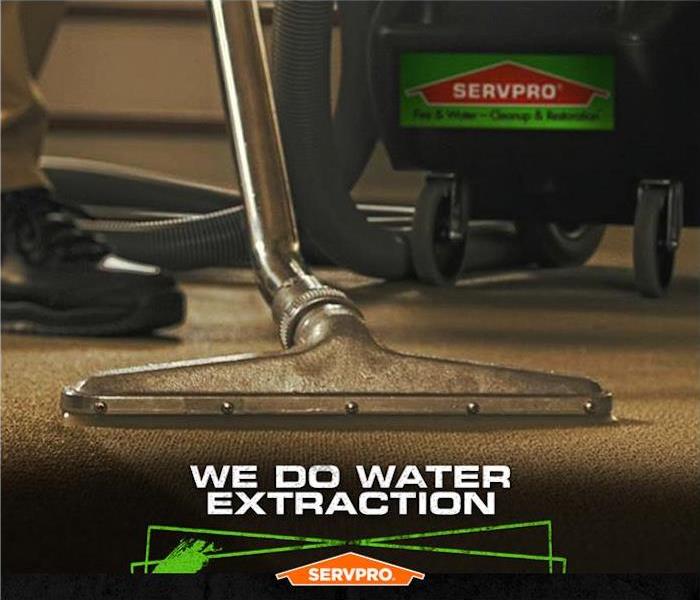 SERVPRO offers advanced equipment to extract water and dry water damaged homes in Syracuse. "Like it never even happened."
SERVPRO offers advanced equipment to extract water and dry water damaged homes in Syracuse. "Like it never even happened."
SERVPRO’s Water Damage Restoration Process for Syracuse Homes
Restoration of water damage to your Syracuse property is a complex process that requires meticulous planning and flawless execution. With years of experience and highly trained technicians, SERVPRO’s streamlined restoration process can save you both time and money.
SERVPRO technicians understand that time is of the essence when dealing with water damage in Syracuse properties. Hence, We’re Faster To Any Size Disaster. We aim to begin the restoration process as quickly as possible to avoid any secondary damage to the structure. The restorative work is divided into several crucial steps, including the following-
- Setting up a staging area to coordinate all activities
- Establishing engineering controls to prevent the contaminants from spreading to unaffected areas
- Water extraction and bulk material removal
- Providing humidity control to accelerate drying
- Cleaning and decontaminating salvageable materials
- Disposing of waste material
- Verification of remediation
Water Extraction After Water Damage to Your Syracuse Property
Extracting the standing water is a key step in the restoration process. Water lingering on materials causes more damage steadily. SERVPRO technicians use several state-of-the-art equipment to extract water from flooded Syracuse properties. Some of the gear that we use include-
Extractors are robust vacuum systems that can drain water from your flooded property. Depending on the amount of water that needs to be removed, SERVPRO technicians might use portable or truck-mounted systems. The portable systems are very flexible as the technicians can carry them to almost any part of the structure, but they require electricity. Besides, the portable systems aren’t powerful enough to move a large quantity of water.
The truck-mounted extractors can offer a lot more vacuum than the portable extractors. As they run on the vehicle’s fuel, they don’t require electrical power.
- Light Wands and deep extraction tools
Light wands and deep extraction tools are attached to the extractors and can remove residual moisture from the carpets and pads. The deep extraction tools can be self-propelled or stationary and work by compressing the rug and pad to squeeze water out, which is vacuumed off by the extractor.
Pumps used in water damage restoration vary in capacity and function. Different types of pumps offer various sets of advantages and disadvantages. The three types of pumps that SERVPRO technicians use for water removal in most residential properties include trash pumps, high-pressure pumps, and submersible pumps.
The trash pumps are very effective in pumping out water containing a lot of suspended solids. However, they offer little lift and are not ideal for pumping water from underground structures such as basements.
Submersible pumps offer a great vertical lift and provide continuous and quiet operation. Technicians can also use submersible pumps in occupied spaces as they work on electricity.
Humidity and Airflow Control
Once the techs extract the standing water for your property, the next step is to provide humidity and airflow control to accelerate the drying process. SERVPRO techs use dehumidifiers and air movers to create ideal drying conditions.
The dehumidifiers remove excess moisture from the air by condensing it into liquid water or absorbing it onto a desiccating media. The goal here is to facilitate the evaporation of water off the wet surface into the air.
Air movers help in the circulation of dehumidified air throughout the structure. As the air movers replace colder, saturated air with warmer and drier air, strategic placement of these pieces of equipment accelerates drying.
SERVPRO is committed to providing quality and reliable service to Syracuse residents and helping restore your home “Like it never even happened.”
Call SERVPRO of East Onondaga County at (315) 446-8776.
Tools and Products Used for Water Cleanup in Syracuse Homes
6/27/2022 (Permalink)
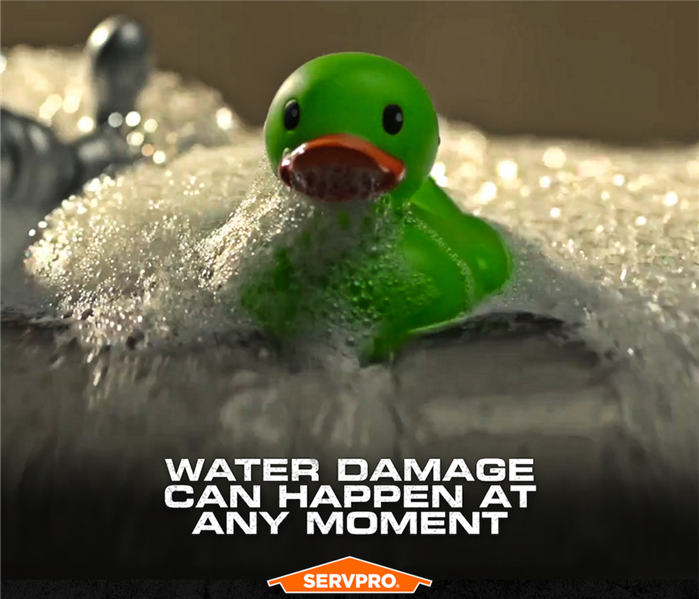 Water cleanup services for your home needs to be addressed by SERVPRO. We provide fast and immediate services at a moment's notice. Call now!
Water cleanup services for your home needs to be addressed by SERVPRO. We provide fast and immediate services at a moment's notice. Call now!
Water Cleanup Involves Several Products
Because water damage is a frequent concern for the city, our SERVPRO team stays ready to help with water removal, drying, and cleanup needs. After mitigation and restoration get underway, we can assess where direct cleaning measures are beneficial.
Structural Drying Solutions
We must address present water concerns before water cleanup in Syracuse homes can officially begin. Our SERVPRO professionals cannot know the full measure of needed cleaning without removing standing water and trapped moisture that could negatively impact exposed structural elements like the flooring.
Carpet Cleaning
Discoloration and embedded soils can threaten carpeted flooring after water damage or floods. We use powerful carpet cleaning tools to dislodge and extract any set-in sediments or soils and improve the color and feel of the fibers.
Wood Flooring Cleaning
Wood flooring can be left with residual films after water gets removed. We rely on thymol and citric-based cleaners to remove these residues and improve the appearance of wood plank after water damage.
Needed Chemical Agents to Prevent Mold
Preventing mold is a key factor in protecting a structure after water damage. Cleanup must include suitable solutions for addressing the threat of microbial growth:
- Chlorines – These products are used for their low toxicity and germicidal action during the cleanup process. Chlorines can also remove stains when discoloration occurs after prolonged water exposure.
- Quaternary Compounds – Quats are designed to destroy microorganisms, so we intentionally use them to attack and overcome fungi and bacteria.
- Phenolics – While these are strong-smelling chemical agents, they can help protect surfaces against future infestations and get made into vapor for faster and more widespread distribution.
Cleaning up after water damage events requires several products and approaches. We carefully evaluate the condition of the house and its contents to ensure that the most efficient techniques are implemented to make losses “Like it never even happened.” Call our SERVPRO of East Onondaga County team today at (315) 446-8776.
SERVPROs Exceptional Water Damage Restoration at a Syracuse Home
5/24/2022 (Permalink)
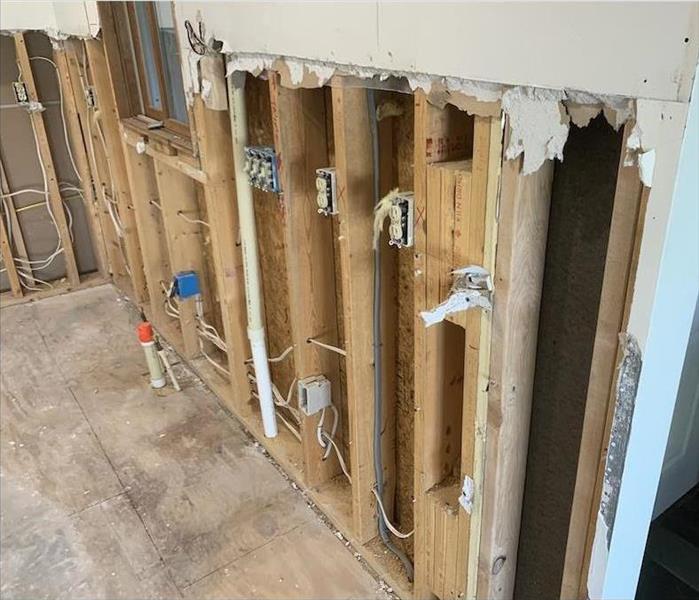 SERVPRO water damage restoration services are second to none. Call now for the help your home needs.
SERVPRO water damage restoration services are second to none. Call now for the help your home needs.
Measures That Aid Water Damage Mitigation in Syracuse
Water damage in your Syracuse home is something you never plan for. So when the incident strikes, you need to dry out and restore everything to its preloss state. Water damage affects your property and its contents. Stopping the water in its tracks helps minimize the damage.
Certain situations could turn water damage restoration in your Syracuse home into a big job. For instance, structural material might have to be torn out and replaced after more than 24 hours of exposure to water. Also, specialized mitigation techniques might be necessary in case of mold growth deep inside walls. By bringing in the right professionals, like SERVPRO, you can restore your home and salvage what you can.
Signs of water damage
- Warped or loose baseboards
- Warped and cracked tile or laminated wood floors
- Under-sink watermarks or mold signs
- Ring-like stains on ceilings
Removing moisture and drying out affected areas
Time is crucial when responding to a water loss because water can quickly absorb various building materials and contents. This causes water damage to spread over a wider area and puts the affected materials at risk of staining, warping, and rotting. When structural materials such as wood and drywall become affected by moisture, severe structural damage can occur.
Removing water from a structure starts with extraction. There are different extraction tools to use depending on the amount of water in your home. For example, a portable extractor works well in restricted areas since it can be carried around. Most extractors feature three components, the heater, pump, and vacuum systems. We only use the vacuum components when removing water; however, we use all the components when cleaning the carpet.
Dehumidification is also essential to help remove water vapor from the air. Additionally, shutting the room's windows and doors prevents more humidity from circulating in, thus enhancing faster drying.
Some activities during restoration may include;
- Ripping out floorboards
- Tearing down walls panels
- Removing mold
SERVPRO of East Onondaga County inspects your home and then mitigates the damage. Call us at (315) 446-8776. We're Faster To Any Size Disaster
Need Cleanup and Water Damage Repairs in Syracuse Homes – Call SERVPRO
1/9/2022 (Permalink)
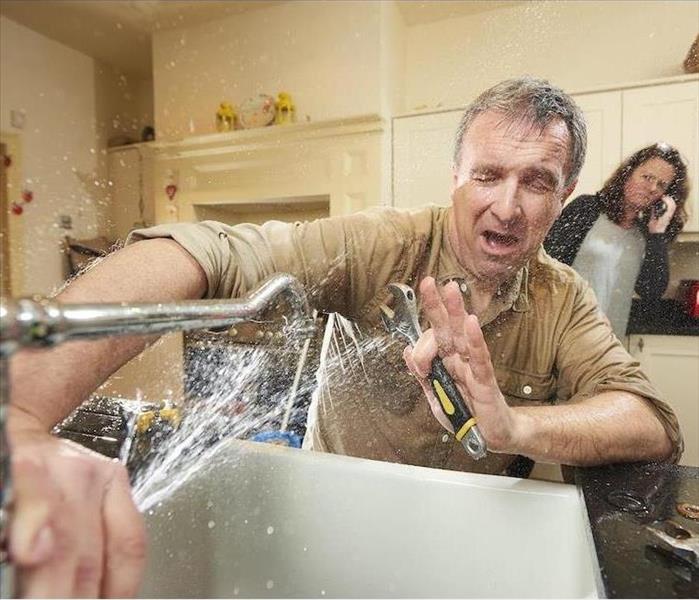 When a sink acts up, you need the help of SERVPRO. Water damage restoration services by SERVPRO are second to none.
When a sink acts up, you need the help of SERVPRO. Water damage restoration services by SERVPRO are second to none.
SERVPRO Can Help with Water Damage Caused by Leaks and Overflowing sinks in Syracuse
One of the most challenging situations to deal with is a leak from a water line inside a wall in your Syracuse home. The leak may start as a drip from a joint that soaks through insulation and drywall. It might be on an exterior wall and then spills out onto the floor. It may appear that a small leak can easily be cleaned up. It can become more serious with the potential for structural damage, including mold growth, causing additional damage.
SERVPRO provides water damage cleanup and repairs for homes in Syracuse and surrounding areas. Our team can investigate and identify the source of the water leak and help with plumbing repairs. We use moisture meters to assess the interior space of walls to determine if there is a high level of moisture inside the wall. Once drywall begins to expand and swell, it will need to be removed and replaced. We dry the interior of the wall before making repairs.
We make every effort to avoid removing structural materials, including flooring, baseboards, and drywall. SERVPRO uses floor drying mats to remove moisture from floors and prevent swelling and expansion of wood floors. Small holes are drilled through baseboards to remove water and moisture to dry the interior space. These are easily plugged and repaired once the interior of the wall is dry.
Our services provided by SERVPRO include:
- Water clean up
- Water removal services from walls, flooring materials, and contents
- Water damage remediation through our fast response and immediate action
- Repairs to structure damaged by water leaks
Call SERVPRO of East Onondaga County in Syracuse and nearby areas. We can help 24/7. Call (315) 446-8776.
Need Water Damage Cleanup and Restoration in Fayetteville – Call SERVPRO
12/12/2021 (Permalink)
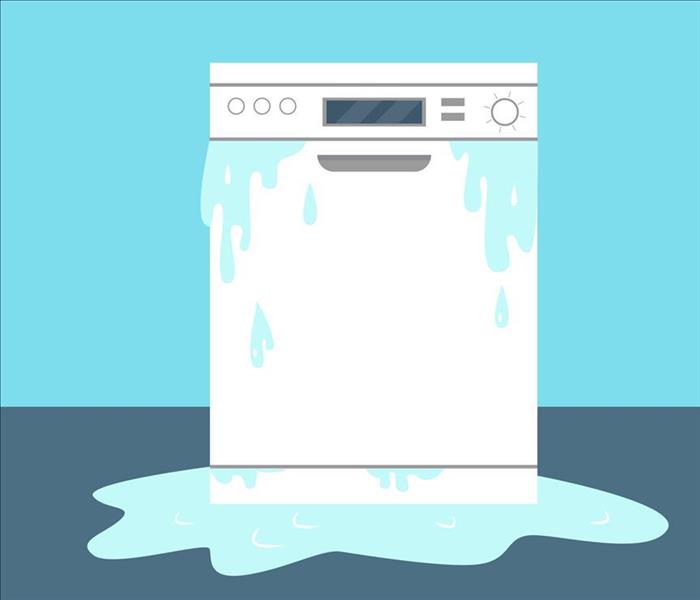 When appliances leak water into your home, SERVPRO should be the first call. Water damage mitigation services by us are top-notch call now.
When appliances leak water into your home, SERVPRO should be the first call. Water damage mitigation services by us are top-notch call now.
SERVPRO Provides Water Damage Cleanup, Moisture measurements, and Drying in Fayetteville
Water leaking in Fayetteville homes from plumbing, condensation from air conditioning units, and overflowing sinks, toilets, and tubs can cause a lot of damage. Even if all the water is mopped up after a leak, there is still water and high moisture levels inside your house. Water might have seeped between cracks in the floor or inside walls or cupboards. Materials in your home or building can absorb high moisture and humidity inside buildings. How do you know when a material like hardwood floors, drywall, or particleboard is dry?
SERVPRO provides water damage cleanup, dehumidification, and drying services in Fayetteville homes and businesses. There are many tasks associated with removing water and drying your home after a water incident. We also measure the moisture content of various structures to ensure that these structures are dry and will not suffer secondary damage later, including mold growth, which can begin growing in as little as 24 hours. Mold can cause health effects.
We use a variety of equipment to remove the water and lower humidity levels within your home: water extractors, dehumidifiers, air movers, and specialized equipment to push air into cavities and crevices. We also measure the moisture content of wood products such as hardwood flooring, furniture, and cupboards in kitchens and bathrooms. For example, if your wood floor has a 20% moisture content reading, it means that 20 pounds of water are in 100 pounds of wood. High moisture levels cause swelling and cupping of the floor and may need to be replaced.
SERVPRO ensures that all household items and structural components are dry and will not be damaged further from high moisture levels. Our services include:
- Water damage remediation
- Water cleanup
- Moisture measurements and specialized drying of your structure and components
Call SERVPRO of East Onondaga County for water damage restoration in Fayetteville and nearby areas. We can help 24/7. Call (315) 446-8776.
Are There Companies Available for Water Damage Remediation in Syracuse?
11/11/2021 (Permalink)
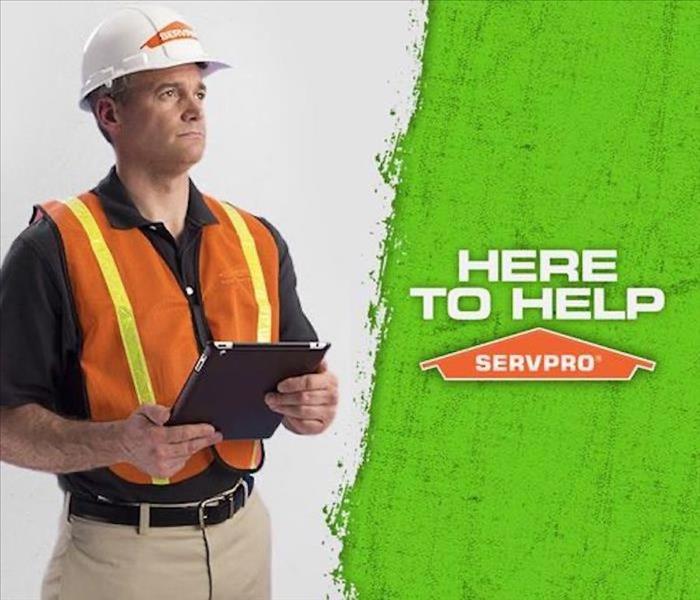 Water damage restoration services by SERVPRO are second to none. We are here to help 24/7 365 days a year.
Water damage restoration services by SERVPRO are second to none. We are here to help 24/7 365 days a year.
SERVPRO Can Help You with Cleaning Up After a Sewage Backup in Syracuse
Nobody ever wants it to happen, but one day your sewer lines could backup. Over time solids running down your sewage drain can build up, causing the pipe to clog. Once debris cannot flow out your sewer lines, it is possible that your bathtub drains or toilet could have water backing up out of them. A clog in your sewage lines could also cause a break in the pipes and force the sewage to pour out into your house.
When conducting water damage removal in Syracuse, our SERVPRO technicians can use various methods based on the source of the problem. If the leak is coming from a freshwater pipe, the procedures will be different from if a bathtub drain or sewer line is the source. When dealing with projects involving sewer backups, we can take special precautions to keep your home safe from the harmful bacteria, parasites, and viruses found in sewage or "black water."
Anytime you suffer from water damage, no matter the source, our SERVPRO team can provide the following services to remediate the issues:
- Basement Flooding Clean Up
- Emergency Services for Water Damage
- Water Removal Services
- Sewage Clean Up
- Water Damage Repairs
- Water Clean Up
When your sewer backs up, several items that get wet will have to be removed due to contamination issues. Our SERVPRO technicians can remove things like your carpet and pad or even your drywall in sealed plastic bags to prevent the spread of contaminants. We can also set up a containment chamber with an air scrubber attached to it to remove harmful particles from the air.
If you ever notice that sewage has backed up and come out of your shower drain or toilet, call SERVPRO of East Onondaga County at (315) 446-8776.
Are There Simple Ways to Deal With Carpet Water Damage Restoration in Fayetteville
10/6/2021 (Permalink)
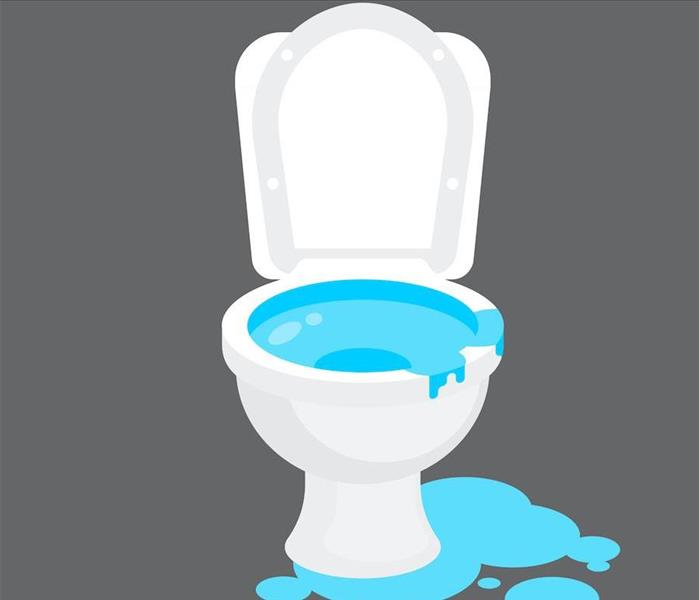 Water damage restoration services by SERVPRO are second to none. Call now for fast and immediate service for your home.
Water damage restoration services by SERVPRO are second to none. Call now for fast and immediate service for your home.
SERVPRO Uses Cleaning as the First Line of Defense Against Carpet Damage by Moisture
Although water intrusions may happen when you least expect, you must be prepared to respond appropriately. Otherwise, the cost of restoring damaged items can be extreme. Carpets are uniquely vulnerable since they lie on the floor of your Fayetteville home, where most of the water collects.
Water damage in your Fayetteville home can manifest in different ways on your carpets, including staining, stretching, bad odor, or delamination. Although some of these issues are structural changes, cleaning can help alleviate them, especially when done by a professional team such as SERVPRO.
Carpet cleaning involves processes such as:
- Bonnet cleaning
- Showcase
- Rotary jet extraction
- Hot water extraction
The primary reason for cleaning carpets is to remove the absorbed water and soils. Timely extraction reduces the duration moisture interferes with the adhesives holding the fibers and backing together, thus reducing the chances of permanent structural damage. Drying the carpets in time is also essential since it complements the cleaning effort by preventing odors, mold and also ensures the carpets regain their usual strength since wetness reduces carpet strength by up to 50%.
Effective carpet drying can be achieved in many ways, including:
- In-place drying without disengaging any section
- Flat drying after disengaging the carpet and removing the pad
- Floating the carpet by circulating dry air beneath it
Floating the carpet can be done with the pad in place or after removing the pad for disposal. Our SERVPRO technicians usually evaluate the situation to determine the suitable approach for minimal chances of damage.
SERVPRO of East Onondaga County has highly trained crews to handle any water damage restoration task, making it "Like it never even happened." Call us at (315) 446-8776.
Efficient Water Mitigation Services in Syracuse
9/2/2021 (Permalink)
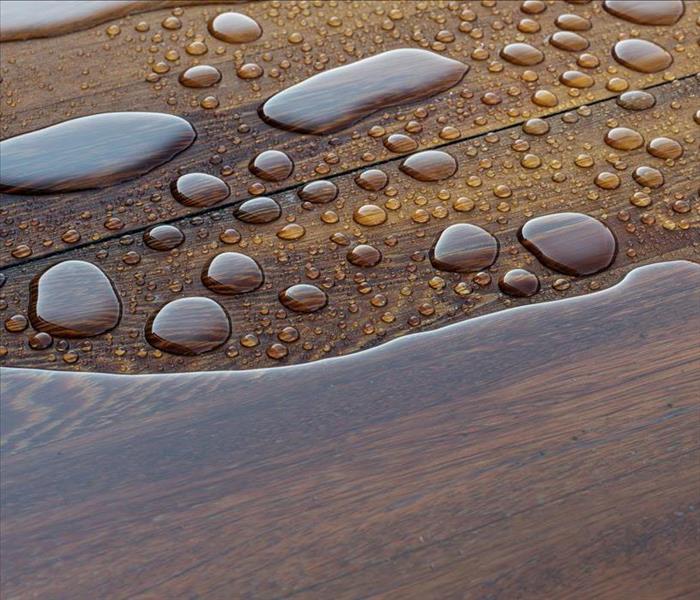 SERVPRO knows how your hardwood flooring can be damaged from water. We come prepared with the equipment your home needs after a water incident occurs.
SERVPRO knows how your hardwood flooring can be damaged from water. We come prepared with the equipment your home needs after a water incident occurs.
Prompt Water Mitigation in Syracuse Homes Prevents Further Devastation
A water intrusion incident can strike your home at any time. For instance, a dishwasher can leak suddenly or spill water on your hardwood flooring because of insufficient maintenance. Beginning the water mitigation process shortly after the water loss incident is vital. Water mitigation involves the assessment, containment, and prevention of further destruction to a home and its contents.
SERVPRO can help you perform water mitigation in your Syracuse home by extracting water using specialized techniques and equipment. Some of the other actions that our team can take during the process include:
- Removing ruined materials, including flooring and drywall.
- Cleaning and applying disinfectants on salvageable materials.
- Using air movers and dehumidifiers to dry the home.
- Ensuring the structural stability of the house.
Water damage mitigation is not designed to replace or repair the destroyed property but to ensure that the incident does not lead to further consequences. Part of SERVPRO’s overall assessment includes determining how clean the water is and its threat to the property’s occupants. We begin water damage restoration following the water mitigation process to return the home to its preloss state.
If your hardwood flooring is affected, we can dry it as soon as possible. Wood materials that remain damp for long periods can sustain permanent damage. Our drying strategy for hardwood flooring concentrates on preventing cupping, warping, or buckling from becoming permanent. If the cup or warp is not serious, our SERVPRO team can take it out through sanding as part of the water damage restoration process. It is not advisable to sand hardwood floors before they are ready for sanding and refinishing.
Typically, we only refinish hardwood flooring when the moisture content level stabilizes to an equilibrium moisture content below 12 percent. SERVPRO has equipment that can force airflow underneath hardwood flooring to dry it from below.
Water mitigation services are essential for preventing further destruction. Call SERVPRO of East Onondaga County at (315) 446-8776 for efficient restoration services. We’re Faster To Any Size Disaster.
What Qualifies As Convenient Water Cleanup In Syracuse Properties?
7/27/2021 (Permalink)
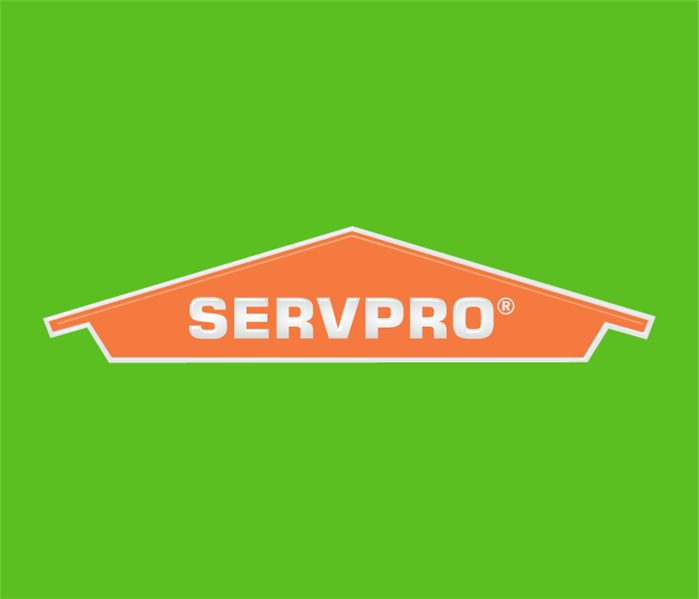 Water clean-up services by SERVPRO are second to none. Call now for the professional help that is needed for your home.
Water clean-up services by SERVPRO are second to none. Call now for the professional help that is needed for your home.
SERVPRO Seeks To Address All Nagging Issues When Delivering Water Removal Services
Although water is a great cleaning utility, spillage causes various problems that can be challenging to resolve. One reason people seek professional water cleanup services is to enjoy convenience during restoration. However, things may not go as planned.
Having an inkling of what to expect during water cleanup in your Syracuse home is crucial. In many cases, cleanup takes more than wiping down surfaces with mops since water seeps into materials causing stains, rust, swelling, and other forms of degradation. Apart from addressing the problems that arise, SERVPRO also takes steps to ensure comfort and punctual outcomes.
Water cleanup is as involving as other remedial processes like:
- Water damage remediation
- Flood restoration
- Water damage repairs
You can quantify the convenience of the cleanup services you receive by considering the state of the property in the aftermath of the process, whether additional damages develop during remediation and how long the process takes.
SERVPRO teams take steps to ensure:
- No strong odors
- No contaminants
- No stains or patches on fabrics or carpets
It is possible to deliver such results because we use specially formulated cleaning agents which biodegrade quickly and have no fragrances. We also take precautions to manage contamination. For instance, we apply antimicrobial agents on surfaces after cleaning. We also dry all traces of moisture, ensuring no further microbial development after finishing the cleaning process.
Dedicating enough resources, including cleaning crews and equipment, ensures faster completion of the process for your convenience and prevention of secondary damage.
SERVPRO of East Onondaga County ensures the water cleanup process is effective enough to resolve any issue, “Like it never even happened.” Call us at (315) 446-8776.
What is the Correct Method for Removing Water from a Property?
3/1/2021 (Permalink)
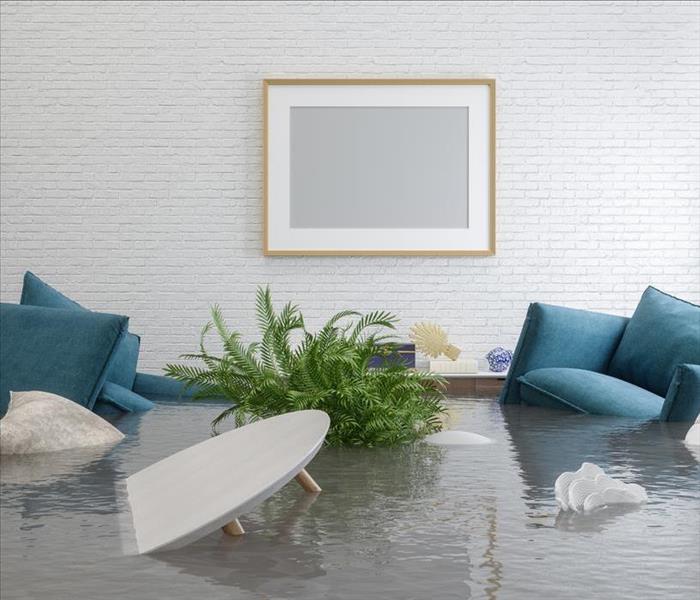 Water extraction should be left to the professionals. SERVPROs team has you covered. Their techs are ready 24/7 365 days a year.
Water extraction should be left to the professionals. SERVPROs team has you covered. Their techs are ready 24/7 365 days a year.
SERVPRO Uses Industrial Pumps and Extractors for Efficient Water Removal in Syracuse Homes.
Large amounts of water can enter a property due to faulty appliances or pipe leaks and bursts. Standing water can quickly migrate underneath floorboards or into wall cavities. The correct method of removing water is to conduct an appropriate analysis of the home and track water migration. An expert water removal service can protect your Syracuse home from unnecessary secondary damages.
SERVPRO technicians can track water migration, working outward from the source using modern water detection equipment.
By conducting a full assessment of the property first, we can help reduce expensive secondary damages like mold growth due to incomplete drying.
- Molds, bacteria, and viruses can thrive in wet-humid environments, which frequently occur due to incomplete water removal.
- Water cavity damage can be expensive and requires specialist equipment such as injectidry systems to dry the cavity properly.
- By adapting air-moving equipment using flex-hose, our technicians can access and dry restrictive spaces such as underneath floorboards or in crawlspaces.
Correct drying methods can help to reduce secondary losses after water intrusion. Contact SERVPRO of East Onondaga County for water removal experts at (315) 277-6767.
Efficient Water Restoration for Syracuse Homes
2/1/2021 (Permalink)
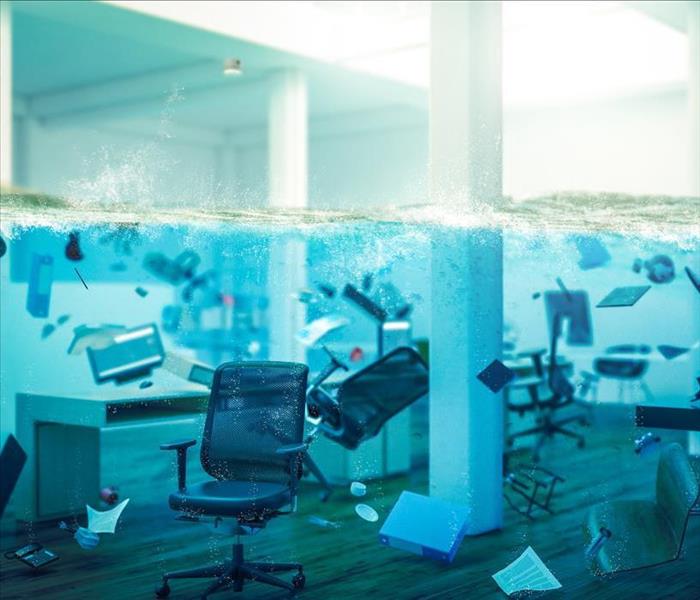 Water restoration starts with knowledge and experience. Call SERVPRO they have the man power and experience for any size disaster.
Water restoration starts with knowledge and experience. Call SERVPRO they have the man power and experience for any size disaster.
Restoring water disasters involves a fast and reliable response from professionals.
With thousands of people who depend on our SERVPRO team's fast response throughout Syracuse, we are continually contending with threats like water disasters. So many sources can cause leaks and flooding within your home, making it critical to address these conditions as soon as possible. Disasters like these can get out of control quickly without mitigation and thorough restoration activities.
Efficient Options for Water Mitigation
Often the recovery process hinges most significantly on the mitigation steps taken by water restoration companies in Syracuse. Usually, this process is led by water removal efforts. While standing water can be incredibly threatening to the property, instruments like submersible pumps and wet vacuums can often overcome these threats. Trapped moisture is another concern, which usually requires other specialty tools to address. Some of these include:
- Weighted extractors
- Carpet wands
- Drying mats
Water disasters can get out of control fast, so trust in our SERVPRO of East Onondaga County to help. We are available 24/7 at (315) 446-8776.
Explore Exhibits at the Great New York Sportsman’s Expo Near Fayetteville
1/11/2021 (Permalink)
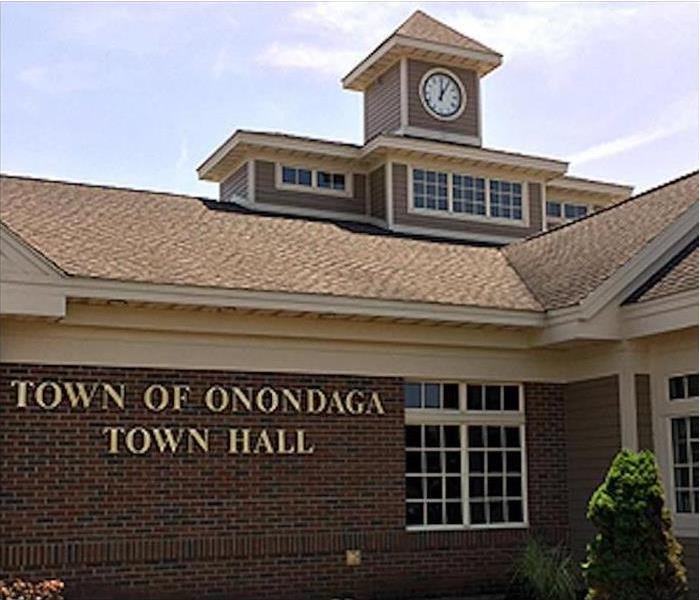 A leaky pipe to storm, we are the team to handle the disaster. Call SERVPRO for the water restoration services needed for the job.
A leaky pipe to storm, we are the team to handle the disaster. Call SERVPRO for the water restoration services needed for the job.
Join Other Residents of Fayetteville and the Surrounding Areas in the Great New York Sportsman’s Expo
Fayetteville residents can visit the nearby Syracuse to enjoy the Great New York Sportsman’s Expo. The event takes place from January 29 to 31, 2021. It is a weekend of exhibits that showcase the latest products in travel, products, and entertainment for fishermen, hunters, and other outdoor enthusiasts. Attendees can explore the shows which feature the latest products in:
- Fishing
- Hunting
- Outfitters
- Outdoors
- Camping
The expo also includes national dock dogs, a custom trout pond, pop up 3d archery shoot, seminars, and trophy bucks, among other things. The hours are Friday 12 noon to 7 PM, Saturday 9 AM to 7 PM, and Sunday 9 AM to 5 PM. The sportsman’s expo is the premier sports expo in Central New York.
SERVPRO of East Onondaga County is glad to welcome you to the Great New York Sportsman’s Expo. If there is water damage in your property, act fast to prevent secondary damage from occurring. Call our restorers at (315) 446-8776 to perform water damage mitigation in your Fayetteville residence.
Eleanor’s Very Merry Christmas Wish the Musical – A Streaming Event for Fayetteville
12/4/2020 (Permalink)
 It will be exciting to see the community enjoying holiday stories!
It will be exciting to see the community enjoying holiday stories!
Fayetteville Residents Will Enjoy the Christmas Story of Eleanor, A Rag Doll
Eleanor lives at the North Pole and loves all her friends there, including Santa and Mrs. Claus and the elves. But she is longing for something more – a home of her own and a best friend. Eleanor decides to send a letter to Santa, sharing her dream with him and asking him to grant her wish.
Your entire family will love this holiday classic. It streams right into your home from Broadway Utica. So, gather the family around, prepare the popcorn and hot chocolate, and prepare to be delighted. Details you need include:
- Showtime is Saturday, December 5, 2020.
- When you order your ticket, use promo code BTLUTI20.
- Once you purchase your ticket, you have 48 hours to watch.
SERVPRO of East Onondaga County provides water damage restoration to Fayetteville and the surrounding areas. We understand how seemingly small water intrusions can cause water damage. If let go, moisture can cause secondary damage, such as mold. Let us provide the proper water extraction and mitigation to restore your home to preloss condition. Contact us at (315) 446-8776.
What is the Best Way of Dealing with Water Odors?
10/29/2020 (Permalink)
 Odors left over from water damage can be rough to deal with. SERVPRO can keep those odors away.
Odors left over from water damage can be rough to deal with. SERVPRO can keep those odors away.
Water Restoration Companies Here in Syracuse Can Help you Overcome Unpleasant Odors From Water Damage. SERVPRO Has Odor Control Technicians (OCT) on Hand.
What causes odor after water intrusion?
Odors can come from multiple sources in your Syracuse home. Sometimes these odors may be the result of pre-existing soiling or debris that is dislodged by water intrusion. At other times, water odors can directly result from water intrusion by bringing in microbial organisms or other contaminants. Finally, high humidity levels in the home can increase our perception of odors. At SERVPRO, our work goes beyond drying and cleaning a structure to ensure that your family returns to its preloss condition. A significant factor in making your home feel normal again is identifying and tackling unpleasant odors. Our odor control technicians (OCT) have a multi-faceted, thorough approach to dealing with unpleasant odors following a water emergency.
How do professional technicians combat smells?
Good water restoration companies understand how to identify sources of odor in your Syracuse home. There could be multiple sources producing unpleasant odors, but the first step is to deal with those that are the most obvious. Noticeable odor-causing elements could be the presence of raw sewage, dirt, trash, pet waste, or molds. Getting rid of these causes can help to increase the effectiveness of odor control. We are trained to clean or dispose of waste appropriately and responsibly. Our technicians follow local and federal guidelines to protect waterways and eliminate potentially dangerous substances in the correct waste facilities.
What are the initial steps for mitigating moisture odors?
- Identify and dispose of odors' source using double-sealed waste bags and a potent disinfectant to eliminate any residual substances.
- Use multiple deodorization methods in a property to ensure that all odor sources are contained and under control.
- Thoroughly dry wet materials and wait for the structure to return to its normal condition before declaring the odor's successful removal.
Can unpleasant smells return to a home after water restoration?
Sometimes water restoration involves removing or resurfacing materials. These issues can occur when there is extensive exposure to moisture, and water begins to absorb into or otherwise deteriorate materials in your contents or structure. Water intrusion commonly causes damages like carpet delamination, varnish discoloration, watermarks, and yellowing of paintwork. Our restoration technicians may strip and refinish floors, repaint walls, or perform chemical treatment of affected areas to tackle these issues. The chemicals used in these processes commonly have a strong odor, which can mask any residual odors that water damage causes. Once these more potent odors pass, the presence of a lighter but still unpleasant odor may remain. SERVPRO works to enlist multiple deodorization processes to combat odor sources that may not be immediately noticeable during restoration.
What are the useful methods of deodorization in a wet property?
- Providing ventilation, air exchange, and air filtration using venting box fans or high-efficiency particulate air (HEPA) filter fitted air-scrubbers.
- Treating potential odorous surfaces and contents using direct spraying of deodorants or injecting into upholstery and other furnishings.
- Fumigating the property can help use wet and dry ultra-low volume (ULV) foggers and ozone generators to break down, pair, or alter odorous particles.
What are the areas of the home most affected by water intrusion?
Most homeowners' central points of concern are experiencing a water intrusion event center around carpets, upholstery, hard surface flooring, walls, and ceilings. These areas typically take on large amounts of water, with most materials being porous or semi-porous. The porosity of the material is a critical factor in odor absorption. Soft furnishing likely absorbs unpleasant odors more readily than non-porous materials like metal or glass. Generally, tackling bad smells in these materials relies on fogging or misting the appropriate areas. Removable fittings like carpets are usually treated on both sides of the surface using an environmental protection agency (EPA) registered disinfectant. SERVPRO technicians can mop hard surface flooring using disinfectant before applying a deodorant through a hand or pressure sprayer. Any other areas of the home with significant odors can be treated using powerful scent repelling pellets.
What is the purpose of water deodorization in residential properties?
- To return the home to a sanitary state by using EPA-registered disinfectants and deodorant chemicals.
- Our services use all necessary products, including biocides, solvents, as well as pressure washing or immersion cleaning for resilient materials.
- Most odor problems are a result of incomplete drying. Our services monitor your home regularly to safeguard it against these issues.
Odor can be an unfortunate by-product of a water intrusion emergency. For assistance, contact SERVPRO of East Onondaga County at (315) 277-6702.
What Does Water Clean Up in A Home Involve?
9/28/2020 (Permalink)
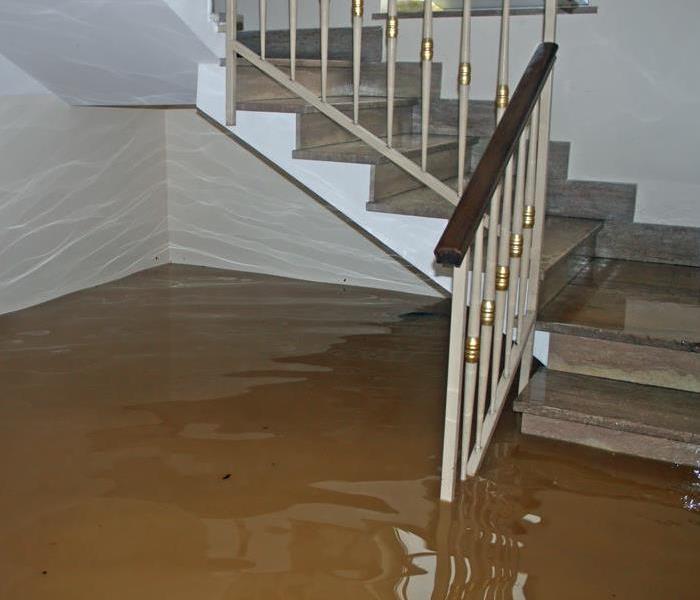 Let SERVPRO take over your water damage clean up in Syracuse.
Let SERVPRO take over your water damage clean up in Syracuse.
SERVPRO Sends Fully Kitted Crews to Perform Water Clean-Up in Affected Syracuse Properties, Guaranteeing a Positive Outcome
Water cleanup may sound like a straightforward procedure only involving stagnant water extraction and drying of wet items in an affected property. However, that is rarely the case since cleanup can involve other difficult tasks depending on the water source and other issues caused by the water loss incident. SERVPRO provides the resources needed to conveniently restore Syracuse properties to their preloss state after any incident that leaves water in unwanted areas of the property.
How does the source influence the water cleanup process in a Syracuse home?
The origin of the water affecting your property can present several challenges depending on factors like:
- Location of the leak within the property
- The condition of the spilled water
- The volume of water involved
The water released into your Syracuse house can originate from any section of the property, such as within the ceiling and walls or in open areas such as around sinks or baths. An elevated source can spread moisture over a vast area because of gravitational flow. On the other hand, a leak originating within an enclosed space complicates the cleanup process by necessitating demolition. If the water is released in a trickle, discovery is likely to take time, allowing secondary issues like mold and other forms of material deterioration to develop. Our SERVPRO technicians can simplify restoration under these conditions since we have advanced equipment and the training to tackle them.
Why does the condition of the water affect cleanup?
Leaks or other intrusions can release water with different levels of soiling. For easier identification of the water condition, or what to expect during the cleanup, spilled water can be categorized in three ways:
- Clean water
- Greywater
- Blackwater
The categorization helps identify the level of soiling or contamination and thus the cleanup steps needed. Water leaks from plumbing lines or appliances are mostly clean or greywater cases since there are no contaminants involved. Regular cleanup procedures are therefore sufficient. However, since microbial processes occur when water sits in a property over extended periods, the greywater can turn into black water, necessitating decontamination processes. Our SERVPRO technicians can help prevent such adverse outcomes since we respond fast when notified of the incident and expedite the cleanup processes using state of the art equipment.
What needs clean up first?
The course of action taken when cleaning a house differs depending on factors like:
- The sections of the property affected by the water
- The vulnerability to moisture damage of materials involved
- The property size
When an incident affects one room or a limited section of the property, decision-making is easier since the volume of the water involved is minimal. The affected materials and type of soiling are also likely to be uniform. For instance, the floor might be carpeted, tiled, or wooden in the entire area, so you do not have to worry about what to prioritize. In such cases, a straightforward approach, such as removing standing water, drying the wet materials, and applying antimicrobial products on surfaces, is sufficient.
If the spilled water spreads all over the house, you have to prioritize some actions or areas to limit the damage levels by the time cleanup is over. Our SERVPRO technicians can help with this by inspecting your property to establish priority areas. For instance, if the standing water affects different rooms with different types of flooring such as carpets, wood, concrete, or tiles, we prioritize extraction from wood or carpet floors before checking the concrete or tiled areas. Water can cause delamination in carpets or buckling in hardwood floorboards. Since such problems are irreversible, removing water from such surfaces during cleanup should be given priority.
Issues like running dyes, stains, mold, or bad odor development can ruin the outcome of the cleaning exercise. Taking steps that minimize the chances of such issues developing is crucial. In most cases, working fast, moving colorfast materials away from areas with vulnerable items should help prevent those problems. Our SERVPRO technicians help in different ways, including testing the affected materials and providing resources such as hand carts for moving heavy furniture items. We also incorporate finishing processes such as deodorization into the cleanup. For instance, we mix water based deodorizers with the cleaning solutions to ensure any odors are replaced with a sweet scent.
In general, the cleanup of a house after a water spill takes more than just applying products and agitating surfaces. Proper planning is necessary to ensure smooth operations also to prevent secondary problems that develop due to delays.
SERVPRO of East Onondaga County can clean up your property after an incident, "Like it never even happened." Call us at any time at (315) 446-8776.
Protect Your Commercial Property From Water Damage
12/18/2019 (Permalink)
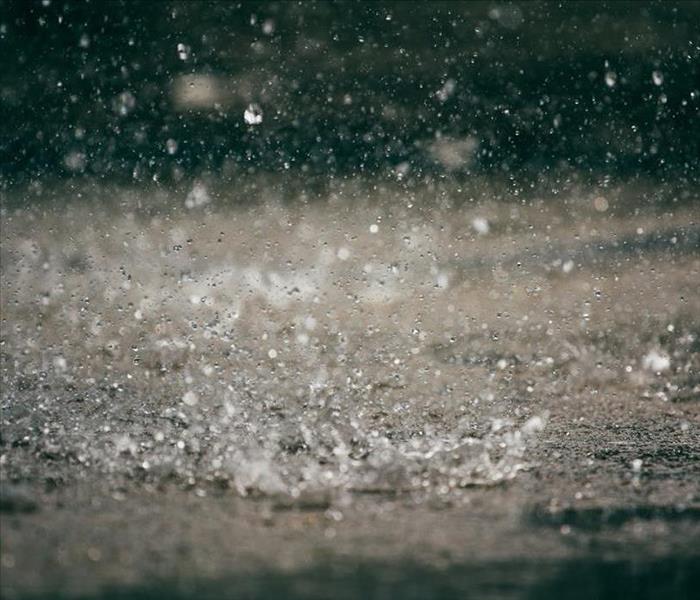 If you are dealing with any water damage, contact SERVPRO of East Onondaga. We have the experienced and resources to handle any size disaster.
If you are dealing with any water damage, contact SERVPRO of East Onondaga. We have the experienced and resources to handle any size disaster.
As the owner of a commercial business, you have a lot on your plate. Your responsibilities are even greater though if you are responsible for the upkeep of the building that you operate out of. A commercial building can have a lot going on, with plumbing and drainage systems that are much more complex than what you have at home.
Suddenly sustaining water damage is every business owner's worst nightmare. You could suffer damage not just to your building but to your inventory, materials or supplies within it. If you want to minimize the chances of this happening, here are some tips to keep in mind.
Get a Tax-Deductible Pump
A sewer or flood backup pump can help remove water from your property as it arrives and hopefully before any significant damage is done. Some cities and towns even offer tax rebates or other beneficial programs to businesses like yours who work to keep their property flood free.
But even if you won't be getting a rebate or deductible out of the job, installing a backup pump is still a good idea. The money you put towards it now could pay off by saving you thousands of dollars in the event that something does go wrong.
Get Every Employee on Board with the Shutdown Plan
You are just going about your day as normal when suddenly, it happens. A pipe bursts or backs up and overflows, and suddenly there is water pouring in where it should not be. After you get over the initial shock, your first priority should be to get to the shut off valves. But a commercial building can have shut off valves in multiple locations.
Make sure as many employees as possible are aware of the location of each shut off valve to use in an emergency. You can’t prevent all damage at this point, but you can limit the damage by thinking quickly and acting fast.
Get Insulated
Plumbing in some commercial buildings will be exposed. If the piping for your plumbing or your manufacturing process is out in the open, this could leave it more vulnerable to freezing, especially if part of your commercial building is not heated in the winter.
If you want to reduce the chances of a pipe bursting and flooding your building due to the frigid cold, pipe insulation can help. Contact a local professional and get every exposed pipe on your property properly insulated.
Get the Number of a 24/7 Emergency Service Before You Need It
Something went wrong and now there's water where there should be none. You can't undo what's already happened, but you can work to get your property restored before further damage occurs. Research the number of a local water damage restoration company now before you need it.
For best results, find a company that offers a 24/7 emergency service. You don't want to let standing water linger over the weekend or a holiday because your chosen contractor is not available. A 24/7 emergency water damage service will leap into action quickly and put you back on the path towards re-opening your business before too much revenue is lost.
No one ever expects water damage to occur, but you can reduce the negative effects by planning for a worst case scenario in advance. Educate your employees on where the shut down valves are located, install a backup pump system if it will help, and reach out to a local water damage professional now to start a relationship before you actually need them.
SERVPRO of East Onondaga provides water damage repair and other disaster restoration services. Contact us today to get help fast.
Do You Have Hidden Water Damage?
11/27/2019 (Permalink)
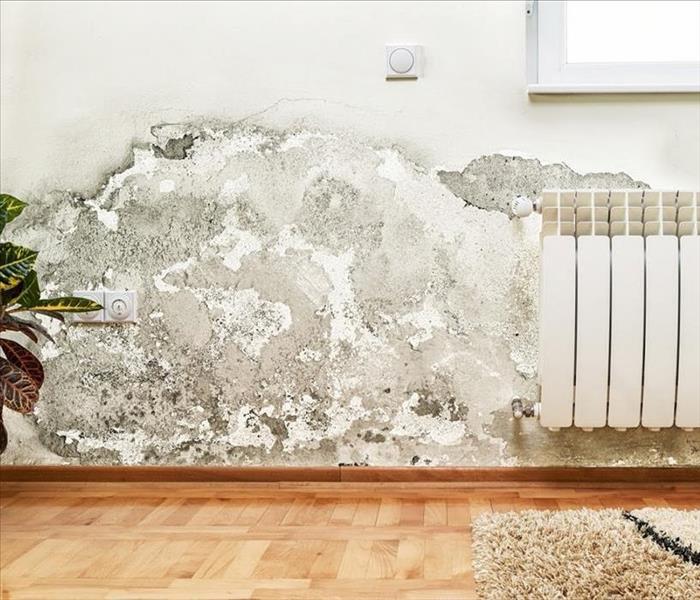 If you are dealing with any water damage, contact SERVPRO of East Onondaga County. We have the experienced to take care of any restoration needs.
If you are dealing with any water damage, contact SERVPRO of East Onondaga County. We have the experienced to take care of any restoration needs.
Small leaks can have huge repercussions, especially if the leak goes unnoticed for a while. For this reason, homeowners need to know the signs of hidden water damage and what they can do if it has occurred.
Common Sources of Hidden Damage
The first step to addressing hidden water damage is to locate where it has occurred.
Roof Leaks
The roof is often the culprit of water damage. Often, water that gets in through the roof drips into the attic, where insulation absorbs the moisture at first. Water damage can accumulate for weeks or months before it is severe enough to drip through to the rooms below.
Inspect your roof regularly for leaks, especially if you have noticed issues like missing or damaged shingles. Go into the attic during a rainstorm, or have someone spray the roof with a hose while you perform the inspection.
Shine a flashlight through the dark attic and look for the glisten of water. You may also be able to spot wet insulation or water damaged joists. The musty odor of mildew or mold may also indicate a leak.
Plumbing Issues
Not all plumbing leaks are obvious. Sometimes leaks happen where drain pipes and water supply lines run through a wall, which keeps the leak hidden from view until the damage becomes severe. Water supply leaks can be more obvious than drain leaks, because you will likely notice increase in your water bill or usage amounts with supply leaks.
Other symptoms of a hidden leak may include water pressure loss or the sound of running water in your walls when the tap is turned off. Walls or flooring near pipes and drains may begin to warp or feel soft. Sometimes mold spots appear on a wall or the paint begins to bubble.
External Factors
Foundation, basement, and wall leaks are also common. These leaks can be caused by storms or from drainage issues around your home. Wind and rain pressure from a storm, for example, can drive water underneath damage siding or through poorly sealed windows. Water runoff, particularly from misaligned gutters or downspouts, can accumulate near the house and seep through foundation and basement walls.
Basements, in particular, are prone to water damage. High water tables and flooding are the most common issues. A moldy or damp odor indicates that water is getting in somewhere. You may also notice visible mold or rotten wall boards or wood.
Damage Restoration Methods
Fortunately, most water damage can be addressed and repaired. Once you fix the cause, you can begin restoration.
Cleaning Advice
Mold and mildew are the main concerns with water damage. You can usually clean mold up by first drying out the affected area and then cleaning it thoroughly with a bleach solution. Wear a mask and eye protection, as mold can be an irritant for some people. The most challenging aspect of cleanup is accessing everywhere that is affected, such as inside carpet padding or the backside of walls.
Restoration Possibilities
Many items in your home can be restored once cleanup is complete. These items include hard flooring, some furniture, and your counters and walls. Hard surface can be wiped cleaned. Stains that can't be removed can be painted over.
If wall board damage is minimal, a fresh layer of drywall compound followed by primer and paint can save the wall. Even wood can be saved from minimal water damage, although it may need to be sanded and stained.
Replacement Needs
Carpets and upholstered furniture are the most difficult items to save after extensive water damage. If you catch the damage early and dry out the textiles quickly, you may be able to avoid damage. Otherwise, mold and mildew can grow deep in carpet padding or inside upholstery. If professional cleaning doesn't remove stains and odor, you’ll likely need to replace these items.
Contact SERVPRO of East Onondaga to learn more about your options after water damage.
All About Mold Infestation After a Water Disaster | SERVPRO of East Onondaga
10/25/2019 (Permalink)
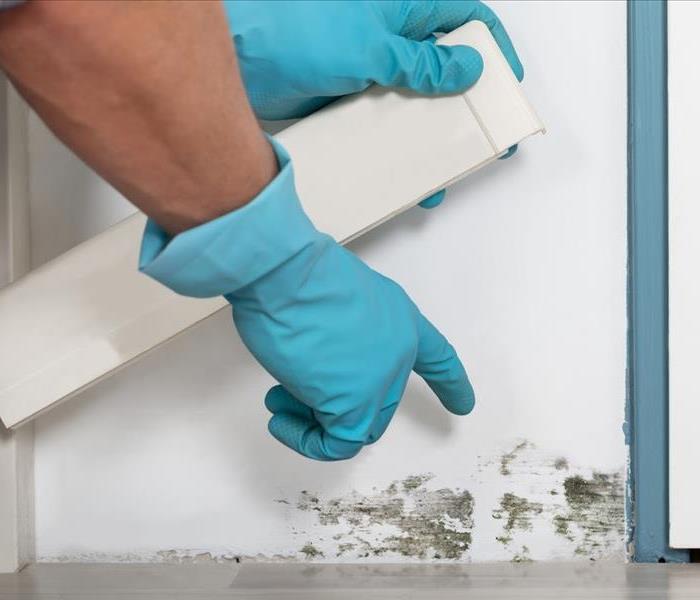 After a water disaster, the time starts ticking to prevent mold from taking hold on your property.
After a water disaster, the time starts ticking to prevent mold from taking hold on your property.
All About Mold Infestation After a Water Disaster
The cause of mold is well-known — an excess of moisture. Well, unfortunately, after a water disaster such as a flood or hurricane, you'll have a lot of excess moisture in your home or business. Even after you've gotten rid of the water itself, the moisture will have likely seeped into the crevices. And that's where you can get mold.
The disaster doesn't have to be huge for your property to be in danger. If you've seen any signs of excess moisture from a bad rainstorm or a water line break, you might have a mold infestation in your future. Find out about the negative effects of mold and what to do about potential infestation.
Mold Damage to Your Property
If your property went through a water disaster big or small, you should expect to have hidden mold. Water from flooding can get into the corners of your home, affecting areas between walls and inside vents, which means that you need to be concerned with more than just what you can see.
Even if you can't see the mold, you might be able to smell it. Mold has a distinct musty odor. If left alone, this odor will sink into permeable surfaces, such as fabrics and drywall, even if the surface itself never got wet.
The more obvious sign of mold on your property is the visual damage it creates. Mold ranges in color from white to black, with gray, brown, yellow, and green mold making an appearance. When you see mold on impermeable surfaces, such as glass or metal, it might not cause as much damage.
However, mold will stain permeable surfaces. Mold stains can be difficult to remove completely, especially if the mold is left to grow for long periods, so have it removed by a professional as soon as you encounter it.
Mold Prevention Directly After a Water Disaster
After a water disaster, you have a small window to prevent mold from taking hold on your property. The Centers for Disease Control and Prevention give the timeframe of 24 to 48 hours. Your main objective is to dry out your property to prevent the mold infestation. You should open all your doors and windows and use fans to dry out the rooms. Make sure the fans are blowing outside, not inside.
Unfortunately, you'll need to get rid of all porous items that got wet and couldn’t be addressed during the 48 hour window. This list will likely include carpets and rugs, but clothing, furniture, and textiles are probably on the list, too. You can clean any non-porous items with a solution of bleach and water.
Unless your water disaster was small — like a washer overflow — you'll probably need professional help to prevent or clean up mold from your property.
Mold Removal After a Water Disaster
Restoration experts will take a comprehensive approach to restoring your property after a water disaster to prevent a mold infestation. For instance, they may inspect your appliances and advise you to discard them. Appliances can harbor mold spores.
Some bigger steps they'll take include removing and replacing damaged wall board. These types of porous surfaces often wick up moisture higher than the water line, so they may have a big project. Wooden trim that got wet will also have to be replaced. They'll probably also examine your duct system for signs of moisture or mold.
You have a lot of problems to overcome after a water disaster. Don't let a mold infestation become one of them. SERVPRO of East Onondaga professionals can get your property dried out and mold free quickly. Visit our website to learn more.
Do's and Don'ts After Flooding
10/1/2018 (Permalink)
We understand that flooding can be a very emotional and stressful time. Your home has water in rooms where there shouldn't be water, your contents have been damaged, sometimes even ruined by the water. And now, you have to take time out of your busy life to try to make things right again in your home.
We will come out to you as soon as possible. We are usually able to get out to you the same day you call, but in case it is a busy time, below are some do's and don'ts for things you can do to help.
What To Do After Flooding
- Remove excess water by mopping and blotting.
- Wipe excess water from wood furniture after removal of lamps and tabletop items.
- Remove and prop wet upholstery and cushions.
- Place aluminum foil or wood blocks between furniture legs and wet carpeting.
- Turn air conditioning on for maximum drying in summer.
- Remove colored rugs from wet carpeting.
- Remove art objects to a safe, dry place.
- Gather loose items from floors.
What NOT To Do After Flooding
- Don't leave wet fabrics in place. Hang furs and leather goods.
- Don't leave books, magazines or other colored items on wet carpet or floors.
- Don't use your household vacuum to remove water.
- Don't use television or other household appliances.
- Don't turn on ceiling fixtures if ceiling is wet, and keep out of rooms where ceilings are sagging.
Preventing Leaky Pipes
7/2/2018 (Permalink)
Stress on pipes can result in leaks which can be expensive to fix, replace and, not to mention, could cause extensive water damage to your home, business and personal items if they burst. Here are some ways to decrease the amount of stress and pressure on your pipes.
High water pressure can feel nice in the shower and it may seem like the dishes are getting done faster but, this can put an unnecessary amount of strain on your plumbing. You can get a hose bib gauge at your local hardware store to test the pressure. Attach it to an outside spigot and open the valve. Normal pressure is between 40-85 PSI so if you pressure measures above this, you may want to consider hiring a plumber to install a pressure reducer. You can also install a low flow shower head in your bathroom to help reduce pressure there.
Hard water is another obstacle as far as pipes are concerned. Hard water is water with a higher than normal amount of mineral content such as calcium or magnesium present. These minerals can build up inside your pipes which restricts flow and in turn, increases the pressure. Deposits can also corrode joints and fittings over time. If you see a white substance on our faucet heads, you more than likely have hard water. If you are unsure or want more proof, ask your local municipality to view the water quality report they are required to have through the Environmental Protection Agency. The only way to effectively soften the water in your home or business is by having a plumber install a water softener.
Wrap your pipes. If you have exterior piping and plan on going out of town in the winter months, take precautions to prevent coming home to a disaster. Wrap your pipes in electrical heat tape or a pipe sleeve which you can purchase at your local hardware store to prevent them from freezing. Remember, if the water is not constantly moving and the cold water pipes touch the exterior of the building when the temperature gets below freezing, your pipes will most likely freeze!
Set the spigot valve. If you have a pipe running through cement to your outside spigot valve, it’s always a good idea to install a frost-free hose bib which allows you to shut off water to the inside of the home preventing freezing.
These are all relatively simple and in expensive ways to protect your pipes that in the end could save you thousands of dollars!
How to Save Your Furniture After a Water Damage
7/2/2018 (Permalink)
Having water damage can be very frustrating and exhausting. We often hear from customers that they have tried to move all of their contents from an affected area, mop up the standing water, and fix the source of the water damage themselves during all hours! We spend our hard earned money on things that make our houses a comfortable and enjoyable environment. The last thing we want is to lose expensive or sentimental pieces of furniture.
There are a few things you can do in order to save your furniture from being ruined in a water damage situation:
-Assess what items have been affected by the water.
-Take pictures to document the water damage and specific pictures of items that have been damaged due to the water.
-Move any furniture out of the affected area that can be moved. The less time the furniture can be sitting in the water, the better. If you cannot move the furniture, try to put something underneath it that gets it up out of the water. For example, you could use wood blocks or aluminum foil.
-If you have wood furniture that has been affected by the water, make sure you put it somewhere it can air dry. Keep the furniture out of direct sunlight as direct sun exposure could cause the wood to crack or warp.
-Apply mayonnaise to any furniture that is lightly water damaged. Apply a thin layer of the mayonnaise and let it sit on the water damaged area for 1-2 hours. Use a damp cloth to remove the mayo from the area. This should remove the water damaged areas.
Tips for Making an Insurance Claim for Water Damage
6/18/2018 (Permalink)
Having a water damage is never something expected. Coming home to a house filled with water can be a traumatic experience. It can be hard to think about the appropriate steps to take to resolve the issue as quickly as possible to limit secondary damage and keep the out of pocket cost to a minimum. Below are some tips to help make filing an insurance claim easier.
Something to Know:
Every insurance policy is different. Therefore, what will be covered may only be determined by reading your policy or calling your insurance agent/insurance company to have them determine coverage.
Knowledge is Power:
Be sure you know who your insurance company is and how to contact them. You may want to list the phone number for your insurance company on your refrigerator for easy access. You could also add your insurance company's 24 hour emergency contact number to your cell phone to have ready at all times. You never know when this information is going to be important.
Stay Calm:
This experience can be upsetting. It's important to stay calm when you are talking to your insurance company so they can ask all the essential questions to set up your claim and get the ball rolling.
Take Pictures:
Document the situation every step of the way to help your insurance company understand the full extent of the damage. Take pictures of every room that sustained damage, structural materials affected and personal items. These pictures will help your adjuster understand the full picture of what happened and what will be involved in restoring your house and the contents affected.
Ask Questions:
Resolving the water damage issue can be very confusing. Feel free to ask as many questions as you can think of to your insurance company so that you understand what will happen next every step of the way. It's important to know what your roles are and what your insurance company will be doing for you.
Use a company with IICRC Certified Technicians:
While there are many companies that may be willing to help you clean up from your water damage, it is important to utilize a company that has technicians who have been trained to properly perform mitigation. SERVPRO prides itself on the fact that our technicians are IICRC certified. Our technicians go through on-the-job training and complete IICRC training so that we can keep up with the latest techniques and technologies to dry your home out quickly to eliminate further damage. Education and training is very important to satisfying our customers. http://www.IICRC.org/education-certification/
Preventing Leaky Pipes
6/1/2018 (Permalink)
Stress on pipes can result in leaks which can be expensive to fix, replace and, not to mention, could cause extensive water damage to your home, business and personal items if they burst. Here are some ways to decrease the amount of stress and pressure on your pipes.
High water pressure can feel nice in the shower and it may seem like the dishes are getting done faster but, this can put an unnecessary amount of strain on your plumbing. You can get a hose bib gauge at your local hardware store to test the pressure. Attach it to an outside spigot and open the valve. Normal pressure is between 40-85 PSI so if you pressure measures above this, you may want to consider hiring a plumber to install a pressure reducer. You can also install a low flow shower head in your bathroom to help reduce pressure there.
Hard water is another obstacle as far as pipes are concerned. Hard water is water with a higher than normal amount of mineral content such as calcium or magnesium present. These minerals can build up inside your pipes which restricts flow and in turn, increases the pressure. Deposits can also corrode joints and fittings over time. If you see a white substance on our faucet heads, you more than likely have hard water. If you are unsure or want more proof, ask your local municipality to view the water quality report they are required to have through the Environmental Protection Agency. The only way to effectively soften the water in your home or business is by having a plumber install a water softener.
Wrap your pipes. If you have exterior piping and plan on going out of town in the winter months, take precautions to prevent coming home to a disaster. Wrap your pipes in electrical heat tape or a pipe sleeve which you can purchase at your local hardware store to prevent them from freezing. Remember, if the water is not constantly moving and the cold water pipes touch the exterior of the building when the temperature gets below freezing, your pipes will most likely freeze!
Set the spigot valve. If you have a pipe running through cement to your outside spigot valve, it’s always a good idea to install a frost-free hose bib which allows you to shut off water to the inside of the home preventing freezing.
These are all relatively simple and in expensive ways to protect your pipes that in the end could save you thousands of dollars!
IICRC
5/21/2018 (Permalink)
The IICRC stands for the Institute of Inspection Cleaning and Restoration Certification. They are a non-profit organization that sets the standards for the cleaning, installation, inspection and restoration industry for more than 25 countries. They offer classes, training and certification.
The IICRC was formed in 1972 by Ed York and was originally intended to be the standard for carpet and upholstery cleaning. Quickly, the organization grew to include water, fire and smoke damage, cleanup and repair, as well as wood, stone and tile cleaning and repair.
How Are the Certifications and Classes Determined?
IICRC’s Shareholders vote to nominate candidates to sit on a Board of Directors which is comprised of 15 industry professionals. The Board only meets four times of year so within the Board, there is an Executive Committee. The Committee is selected once a year at the fall meeting. The Board, along with the Committee, determines the direction of the organization while still following the ethics and guidelines set in place by IICRC. The Board determines what classes and certifications are necessary throughout the industry. The IICRC does not own schools or hire instructors but rather approves them to teach classes according to the organizations standards.
For more information on the IICRC, you can visit the website here: http://www.IICRC.org/
Downspout Extensions
5/16/2018 (Permalink)
When heavy rain occurs, water can likely end up getting inside your home causing expensive damage. When water pools around the foundation from the roof or gutters it can leak through the basement walls. One thing that you can do in order to avoid water damage from heavy rain is to install downspout extensions. These extensions will force water away from the foundation from the home. They are simple to install and there are a variety of different types to choose from.
You can look at your local hardware store to see what your options are. Some extensions look the same as the downspout, but add length making it so the water flows further from your home. There are also cement extensions which stay in place a little better than the plastic or aluminum extensions.
Additionally, it is important to check your downspouts to ensure that they aren’t blocked by leaves, or debris. If the downspouts become blocked, water may intrude under your roof causing water damage to your ceiling.
Laminate Flooring Water Damage
5/16/2018 (Permalink)
Laminate flooring comes in many different looks and can be a great choice when replacing flooring. However, water damage to laminate flooring can cause have many potential problems. If possible, avoid putting laminate flooring down in rooms that are could potentially have water damage. Use caution when installing laminate flooring in kitchens, bathrooms, laundry rooms and basements.
Water can cause laminate flooring to detach and break down. Water can cause laminate flooring to permanently buckle, in which case replacing would be necessary. Many times when we see water damage to laminate flooring, we would recommend removing it in order to avoid mold growth and to allow the subflooring to completely dry in a timely manner.
When laminate flooring is placed in bathrooms, kitchens and laundry rooms, some of the appliances in those rooms can slowly leak water which seeps underneath the laminate. This leakage can go unnoticed until buckling or mold develop. Basements can accumulate water during heavy rain storms, leaky pipes or when sump pumps fail damaging your beautiful flooring.
Placing a vapor barrier down can eliminate some of the damage. Being conscious of any leaks or damaged ocurring to your flooring is important. It is easier to clean up from water damage immediately when it occurs rather than letting it set, therefore, deteriorating the structure of your home.
Why you Need a Sump Pump
4/16/2018 (Permalink)
Have you ever had water in your basement or crawl space? Some basements and crawl spaces may get water inside of them after a heavy rain, quick thaw, or a long rainy season. Installing a sump pump in these areas can help keep these spaces dry and stop your property and contents from sustaining water damage. You can choose to install a sump pump yourself of have a plumber come and put it in for you. Sump pumps can be purchased from your local hardware store and usually require approximately a 2 foot by 18 inch hole to set in. Water flows into the hole and immediately gets pumped out through a pipe that leads away from your home.
When you have the sump pump installed, somethings you should consider is:
- How will the sump pump run if the power goes out? Generally the sump pump is plugged in, and therefore would not work if there was no power going to the home. Storms often trigger the power to turn off, so an alternate power source is important. You could keep a generator handy to hook up if the power were to go out. Another option would be to have a back up battery that would automatically turn on if the power went out. The battery would need to be able to withstand long periods of inactivity.
- What if my sump pump stops working? We often recommend to homeowners to have a back up sump pump handy and ready for use should yours stop working. It can take a lot of time to get a plumber out to the house to have them fix the sump pump, in this case, you would want to be able to hook up an alternate sump pump in the mean time to stop the sump pump pit to overflow causing water damage to your home.
Do You Head South for the Winter?
12/7/2017 (Permalink)
Before heading south for the winter, you should definitely check out these important preventative measures to protect your home!
- Make sure your furnace is set no lower than 55 degrees. There are new thermostats that are considered “smart thermostats” so that you can control the temperature of your home from your phone from anywhere. The Nest https://nest.com/thermostats/ the thermostat that we use in our home and is so easy to use and manage.
At SERVPRO we have talked to many homeowners who live in the south for winter and have had their heating system fail while they’re away. This leads to frozen pipes that can be undiscovered for long periods of time. Not knowing that your heating system has failed and pipes breaking while your away can lead to water and mold damage that affects large areas of the home.
- Winterize your pipes. Shut off the main water supply and drain the system by opening all faucets and flushing the toilets. You may also consider replacing the water traps and drains with a nontoxic antifreeze. Don’t think this is something you want to do yourself? Plumbers will come winterize your home for you.
Damaged Contents
9/30/2017 (Permalink)
When we think of storm and water damage, we often think of structure damage. Did you know that SERVPRO offers content restoration for your affected contents as well? Your contents can be your most valuable and meaningful belongings. We wouldn't want you to have to throw away damaged contents because the water damage they may have endured leads to mold damage and staining.
Our technicians are specially trained to restore contents damaged by mold, water and smoke. Our technicians start by spot cleaning items to determine what cleaning techniques will work best based on the materials the item is made of and the type of damaged the item sustained.
The types of cleaning we offer are:
- Dry Cleaning - Used for cleaning light residues or to pre-clean prior to cleaning.
- Wet Cleaning - An effective cleaning method for removing moderate to heavy residues.
- Spray and Wipe -Effective for items that can’t withstand cleaning.
- Foam Cleaning - Used for upholstery fabrics that might shrink or bleed if cleaned.
- Abrasive Cleaning - Involves agitation of the surface being cleaned.
- Immersion Cleaning - Contents are dipped into a bath of the cleaning product.
If your home or office requires extensive restoration, a pack out may be required. In this case, the SERVPRO team would inventory and pack out all contents and move them to our office. There, the team would clean all contents and store them in our climate controlled containers until you are ready to have your contents brought back.
We work with you for 100% of this process letting you make decisions and offering solutions to possible problems along the way. Pack outs, storage, and pack backs are often covered by insurance. We work with your adjuster to ensure they understand any type of necessary cleaning and pack out.
Water Intrusion
5/24/2017 (Permalink)
Water Intrusion
Have you ever had water leak into your home through your roof? If so, you understand the ways a roof leak can cause damage in your home. If you haven’t experienced a roof leak- you’re lucky!
It is important to understand the condition of your roof. Knowing that roof maintenance will be needed and what types of maintenance will be required can be helpful! Roof repairs and replacements can be very costly, it helps to know in advance so that you can prepare.
If water starts leaking into your home it can cause a lot of damage in a short period of time.
Damaged shingles is one of the most common sources of roof leaks. Having damaged or missing shingles, it is important to replace them as soon as possible. Missing or damaged shingles will allow a lower layer of the roof to be exposed to nature’s elements and can allow water to seep through the uncovered spaces.
Nails that have backed out due to extreme weather should be hammered back in securely. When the nails are raised or fall out, allows water to seep in.
Flashing that is improperly installed or have been damaged allows water to enter through gaps. Have them inspected to ensure they are properly installed and are well maintained.
Clogged gutters can cause water to back up and overflow onto your roof. This would cause water to possibly intruder into your home through the underside of the roof. If you notice water stains around the perimeters of your home, water maybe backing up into your home from your gutters. Also, gutters that are not pitched properly don’t allow the water to flow the correct direction to the downspouts causing the same damage as a clogged gutter.
Skylights often have leaks if they are not installed properly or have seals that are worn and cracked. Water can seep into the home from the skylight causing damage.
Sometimes water damage from a roof leak goes undiscovered for a long time because of the insulation in the attic or crawl space. It takes a lot of water to seep into the home, soaking the insulation before it reaches the ceiling and walls. In some cases mold forms before water intrusion from the roof is noticed.
If you think your roof needs attention, call a roofer to have them inspect your roof. They can tell you what kind of shape your roof is in, inform you of any repairs that are necessary and give you a quote for the repairs.
Plumbing Checklist
5/24/2017 (Permalink)
Plumbing problems cause a lot of the water damages that we hear about. It is important to ensure that the plumbing in your home is working properly and have any problem areas fixed.
You should check for:
- Signs of leakage. Ex. Water/puddle marks
- Corrosion
- Signs of bad pipe connections
- Water pressure. Low water pressure may be caused by a water line problem or sediment build up.
- Any exposed pipes, ceilings and walls that may have pipes in them. If you see water stains or smell a musty odor.
Know where your water supply line valves are. It is important to be able to turn the water off to certain areas or turn off the water completely to your home. In an emergency situation you could completely shut off the water to your home until a skilled plumber can come fix the leak.
Syracuse Breaks 100 Year Old Rainfall Record
5/8/2017 (Permalink)
Have you noticed the Syracuse area experiencing a large amount of rainfall this year? We have had a record setting amount of rain to date! 0.69 inches fell on May 5th as of 3PM alone.
To the west of us, Buffalo received more than 6 inches of rain in April. As of May 5th, Buffalo had already received 3 inches of rain this month! 3 inches of rain is the typical amount of rain Buffalo normally receives in an entire month.
Many of the local lakes, streams, rivers and canal ways are flooding. Over the weekend, events surrounding the Syracuse Creekwalk were canceled and the Creekwalk has been closed for some time due to high water levels. Parts of the Creekwalk are flooded making it unsafe for people to use that area. Lake Ontario water levels are nearing 2 feet above average and are expected to continue rising.
In Oswego County, a beaver dam burst causing water to pour all over State Route 183. Also in Oswego County, a swamp along Lakeshore Road flooded causing the town to close the road completely.
Onondaga Lake Park, had massive flooding throughout the park. High waters in the park caused some of the park benches to be taken into the lake as water levels began to shrink.
Remember, it is important to watch for flood warnings in your area. There are safety precautions that should be taken for health and safety reasons. Do not walk, drive or ride through flooded waters, because you do not know what is underneath the water that could harm you. If you must travel, find detours that lead around the flooded waters.
Have you had flooding in your area?
Roof Tarping
4/6/2017 (Permalink)
Did you know that your local SERVPRO offers roof tarping? That’s right, our SERVPRO offers emergency service tarping. When you call our office, day or night seven days a week someone will be there to answer your call and we will come out to start work as soon as possible. Because you never know when you’re going to need this type of service and you never plan for it!
As we approach the heavy rain season, some homeowners may discover that their roof needs repair. You may also find that your skylight is not air tight and is allowing rain to come into your home causing further damage.
For scheduling, financial or weather related reasoning, you may not be able to have the roof or skylight immediately repaired to stop the water from trickling in. However, it is important to prevent water from getting into your home. As a result, tarping is necessary. Our skilled technicians will identify the damaged section of the roof, checking for damaged tiles and check the interior of the home for leaks. We can then tarp the damaged area of the roof to stop water from entering the home. Any water damage that has occurred inside the home can be mitigated by our technicians to stop further damage in your home.
This way, when you are ready and the weather allows, you can have a roofing contractor come and either fix or replace your roof.
Preventing Basement Flooding
4/4/2017 (Permalink)
April showers bring May flowers! The spring time can be a very moist season in CNY. This week for example, has a large amount of rain predicted in the forecast. Forecasters have even issued a flash flooding storm watch lasting several days.
All of this rain may have you thinking about ways you can prevent basement flooding this spring. Whether you have a finished or unfinished basement area, a flooded basement can be very stressful.
Take the following steps to prevent a flooded basement:
- Keep gutters and downspouts free from any debris. Clear out any leaves, gravel or anything else that may have formed a blockade in your gutters and downspouts.
- Make sure downspouts face away from your home. If the ground around your downspout has a slant, make sure that when the downspout empties the water is not going to flow back towards your home.
- Fill cracks in the foundation with an epoxy.
- Check your sump pump. Make sure the area is cleared from debris and that your pump is in good working order. You may want to have a back up sump pump or an alternative electrical source for the sump pump incase the power goes out.
- Examine sewer systems and septic tanks.
- Install window wells on any windows that lead to a lower level. Check the window to make sure it is water tight.
- Check over your homeowner’s insurance policy to make sure you have the correct coverage. We often find that homeowners do not have a sump pump rider on their policy; therefore there is no coverage when a sump pump fails.
It is important to take the right precautions. Completing these steps will not be full proof to preventing water damage. However, it will minimize the risks.
Water Damage Alarm
2/14/2017 (Permalink)
What if we told you there was something you could hook up in your home that would alert you when water penetrated an area of your home you didn’t want it to?
Worried about your dishwasher leaking? Concerned about your water heater being old and water seeping out of it? Nervous about having your sump pump fail? Having an alarm that would sound if water infiltrated an area that it was not suppose to be could be helpful in many different spaces in a home or business. If there is an area of your home that has had previous water damages that you may be worried about happening again this water damage alarm could make you feel more comfortable.
If there is a space in your home that you don’t go often, this alarm would notify you of any water damage that occurs. Often, people have areas of their homes they don’t go into on a daily basis. For example, many people don’t or can’t go into their basement every day. Water damages occur in these areas and sit for long periods of time without being noticed. In the mean time, secondary damage occurs. Mold grows, contents get ruined and the already expensive damage becomes a lot more expensive than if it was discovered at the time of loss.
While browsing Amazon.com I found that many of the water damage alarms cost anywhere from $12-$50. When you think about the cost it may save you in the long run, it’s well worth the money! Consider purchasing one (or a few) of these alarms in your home to alert you of a water damage.
How to Save your Furniture after a Water Damage
1/24/2017 (Permalink)
Having water damage can be very frustrating and exhausting. We often hear from customers that they have tried to move all of their contents from an affected area, mop up the standing water, and fix the source of the water damage themselves during all hours! We spend our hard earned money on things that make our houses a comfortable and enjoyable environment. The last thing we want is to lose expensive or sentimental pieces of furniture.
There are a few things you can do in order to save your furniture from being ruined in a water damage situation:
-Assess what items have been affected by the water.
-Take pictures to document the water damage and specific pictures of items that have been damaged due to the water.
-Move any furniture out of the affected area that can be moved. The less time the furniture can be sitting in the water, the better. If you cannot move the furniture, try to put something underneath it that gets it up out of the water. For example, you could use wood blocks or aluminum foil.
-If you have wood furniture that has been affected by the water, make sure you put it somewhere it can air dry. Keep the furniture out of direct sunlight as direct sun exposure could cause the wood to crack or warp.
-Apply mayonnaise to any furniture that is lightly water damaged. Apply a thin layer of the mayonnaise and let it sit on the water damaged area for 1-2 hours. Use a damp cloth to remove the mayo from the area. This should remove the water damaged areas.
Songs About the Great Flood of 1927
5/18/2016 (Permalink)
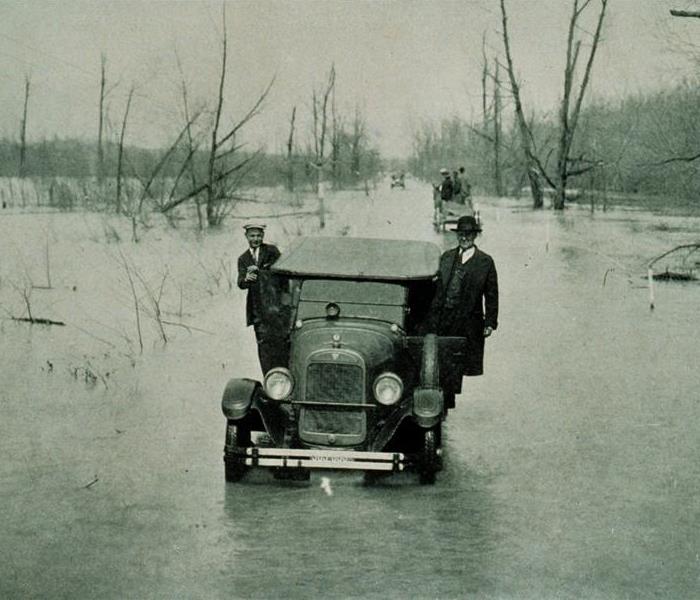 The Great Flood of 1927.
The Great Flood of 1927.
The Great Flood of 1927 of the Mississippi River not only changed the landscape of the region, the people and government regulations but their culture as well. Many musicians were inspired to express their feelings at the time of the disaster and others continue to do so through conveying those emotions which they so closely associate with those in peril at the time of the flood. Below are some of the most well-known songs about the flooding in 1927. I have collected primarily songs from the blues genre although you will find some other styles mixed in. Some of these songs and artists have stories and information to share outside of the songs themselves and others simply leave the music to do all of the talking. I encourage you to listen to the songs by clicking on the title, the emotions behind them and add any other songs about the flooding of 1927 that are not mentioned in the comment section below.
Memphis “Minnie” McCoy and Kansas Joe McCoy – When the Levee Breaks
This is probably the most famous song that came about from the Great Flood of 1927. Many African Americans were forced to work, often at gunpoint, on the levees as the river waters rose during the flood for the Mississippi in 1927. At this point in time, many blacks worked on plantations in the Deep South and rented homes from the plantation owners. When the flood came, they had nowhere to go and were forced to move North to find better jobs. This song rose to fame when rock band Led Zeppelin covered it and released it in 1970.
Bessie Smith - Back Water Blues
This particular song is written about the very early stages of the flood of 1927 which actually started all the way in Tennessee on Christmas Day of 1926. This blues and jazz standard is about the Cumberland River which flows through Nashville and contributed to the overall flooding in 1927.
Barbecue Bob – Mississippi Heavy Water Blues
Charley Lincoln - Mississippi Low-Levee Blues
Barbecue Bob wrote “Mississippi Heavy Water Blues” about the flood of 1927 and years later his brother, Charley Lincoln (also known as Laughing Charlie) wrote the sequel “Mississippi Low-Levee Blues.”
Charley Patton- High Water Everywhere Pt 1 and 2 – Bob Dylan Covered
It is believed that Patton was referring to Greenville, Mississippi in this song where African Americans were held after the flood and not allowed to leave by the landowners for fear that they wouldn’t not return to the Deep South and work the plantations. “High Water Everywhere” is debatably one of Patton’s best works and often hailed as his magnum opus.
Terence Blanchard- Ghost of 1927
While this song is obviously inspired by the flood of 1927 it was actually written circa 2006-2007 for film director Spike Lee’s four hour award winning HBO documentary “When the Levees Broke: A Requiem in Four Acts” about the aftermath of Hurricane Katrina in 2005. What resulted was Blanchard’s album A Tale of God’s Will (A Requiem for Katrina) compromised of songs about the flooding of the Mississippi region throughout the years. This album won a Grammy in 2008 for “Best Large Jazz Ensemble Album” and the song “Levees” was nominated for “Best Jazz Instrument Solo.”
Randy Newman – Louisiana 1927
Aaron Neville - Louisiana 1927
Newman wrote this lamenting song in the perspective of an anonymous resident of the Saint Bernard and Plaquemines parishes recounting the aftermath of the flood. He describes the callous response from the government, the sheer volume of water and the scope of disaster. After Katrina hit, Aaron Neville of The Neville Brothers performed his own version of the song and revived “Louisiana 1927” in way that it not only became the theme song after Katrina but is now considered a Louisiana folk song, staple and standard.
Zachary Richard – Big River
This song is off Richard’s 20th album Le Fou which was strongly influenced by his roots in Louisiana as is all of his music but more specifically, the BP Oil Spill. This album is hailed as his best and Richard splits his time between Scott, Louisiana and Canada where he is most well-known.
Other songs about the Flood of 1927:
Blind Lemon Jefferson – “Rising High Water Blues”
Lonnie Johnson – “Broken Levee Blues”
Eric Bibb – “Flood Water”
Jed Hopkins and Sarah A Westcott – “The Mississippi Flood Song “
Joe Hoover – “Mississippi Flood Song”
Big Bill Broonzy – “Big Bill Blues,” “Southern Flood Blues,” and his cover of “Back Water Blues”
The New Lost City Ramblers – “Mighty Mississippi” (originally written by Kelly Harrell)
Al Craver (Vernon Dalhart) - “The Mississippi Flood”
Arthur Fields - “Terrible Mississippi Flood”
Norfolk Jubilee Quartet - “The Old Account Was Settled Long Ago”
Bartmon Montet and Joswell Dupuis - “L’Eau Haute” (High Water Waltz)
The Most Destructive Flood in American History
4/25/2016 (Permalink)
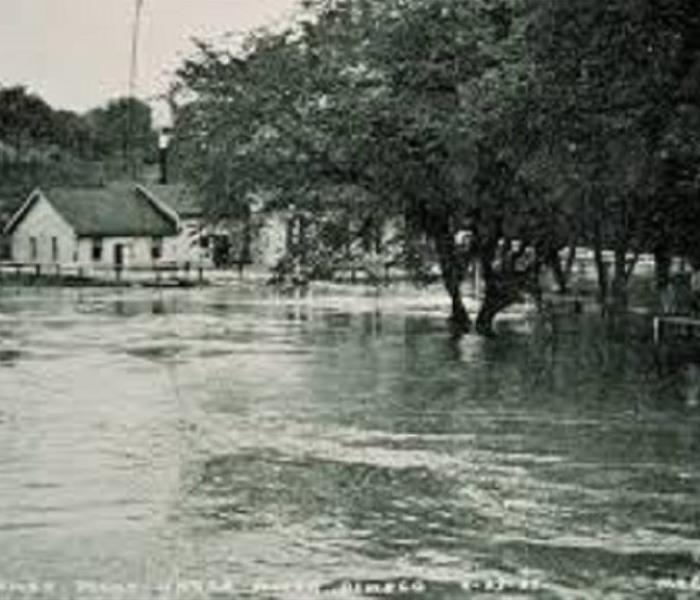 Mississippi Flood of 1927.
Mississippi Flood of 1927.
The Great Mississippi Flood of 1927
The flooding of the Mississippi River in 1927 was the worst flood in American history. At the height of its power, the flood affected an area approximately 27,000 square miles affecting the states of Missouri, Illinois, Kansas, Tennessee, Kentucky, Arkansas, Louisiana, Mississippi, Oklahoma and Texas with Arkansas being hit the hardest. At one point the flooded area was 50 miles wide, a 100 miles long and 30 feet deep. 500 people were killed, 600,000 were left homeless and there were 350 million dollars in damages – approximately 5 billion dollars today.
How did it happen?
Heavy rains came down in late 1926 and kept falling from the sky well into 1927. The tributaries of the Mississippi started to become burdened and the levees overflowed. The single greatest weak point in the levee system was at Mounds, Mississippi but authorities assured residents that the levee would hold. Slaves were made to pile sandbags on top of the levee but once one leak started, the water flow continued to increase. The levee started to shake and eventually collapsed with water flowing more than double the volume of Niagara Falls. The Mounds Landing levee break was significant in that after its collapse, the entire levee system along the river broke. Mounds Landing is known as the most severe levee break in the history on the United States to this day.
Changes
The Mississippi Flood of 1927 brought about many changes to the region and the entire country. Racial tensions soared high and many African Americans migrated north resulting in what is now known as the Great Migration. Under the Flood Control Act of 1928 the world’s longest system of levees were built. In 1941 Congress authorized the U.S. Army Corp of Engineers Yazoo Backwater Project which utilizes levees, connecting channels, drainage structures and pumps to prevent flooding in the Mississippi Delta. The Great Flood of 1927 will always be remembered and continues to affect our country, its geography, its people, culture and our landscape to this very day.
What is a Levee?
4/11/2016 (Permalink)
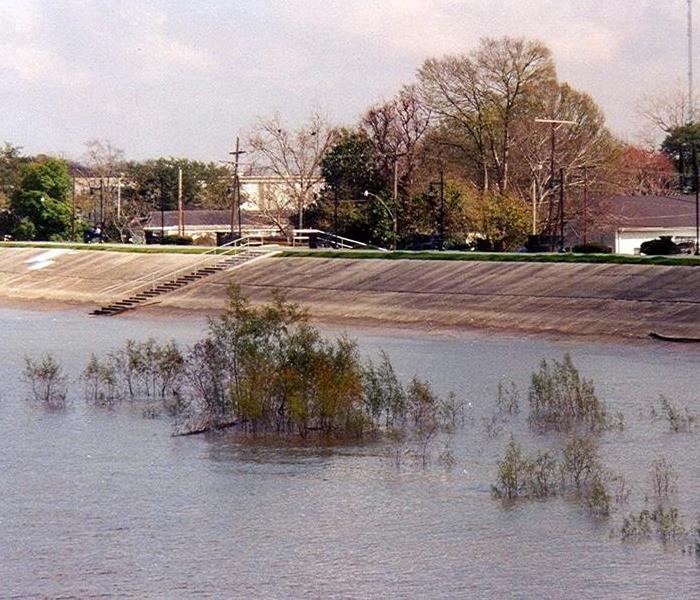 Levee on Mississippi River.
Levee on Mississippi River.
Levees are natural or artificial embankments made to regulate water flow, prevent flooding, overflowing or to keep certain areas of land dry. People have been attempting to control rivers, oceans and seas for thousands of years through the use of levees.
Natural levees are made of sediment pushed to the side of river banks causing the sides to be significantly higher than the river bed. Manmade embankments are often made of soil, sand and rocks but can also be made of wood, plastic and in some severe cases, concrete. On top, a flat surface is typically left on which sandbags may be piled even higher if needed.
Levees usually run parallel to the course of a river or flood plain to divert the water flow in as natural a manner as possible. If there are any spaces between levees on the same riverbank, the levee becomes useless. This may seem like common sense but it was an issue when the first levees were built by individuals who owned property along riverbanks and not government organizations.
7 Ways to Maintain Your Septic System
4/4/2016 (Permalink)
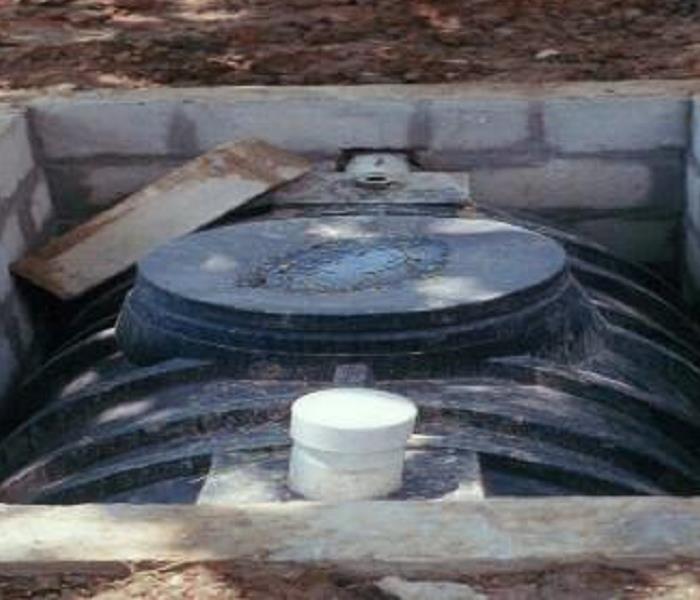 Septic System.
Septic System.
It is important to maintain your septic system for the health of your family, your community and for monetary reasons as well. Your septic system is an integral part of your household and the importance of it may not be fully realized until there is a problem. To prevent problems and major life inconveniences involving your septic system, there are a few simple procedures and rules to follow for its maintenance.
1) Regularly inspect your septic system. Get in touch with an On-Site System Maintainer to regularly inspect your system routine maintenance can save you a lot money in the long run.
2) Locate your septic system, take a picture of where it is in your yard and put it in a file. This will save a lot of time and aggravation later when you have to get your system pumped. You can also have risers installed to make the pumping and monitoring of your system easier and less time consuming.
3) Pump your system. Different systems call for different lengths of time between pumping and cleaning out your system. Typically your system should be pumped every 3-5 years. If there are a lot of people in your home or you use a lot of water, you may want to consider pumping your soon. Household amenities like garbage disposals, hot tubs and whirlpools can wreak havoc on your system so if these are present, shoot for every 2-3 years. It’s best to consult our septic system handbook, look it up online, or get the opinion of a professional for a more exact length of time between pumps.
4) Be water conscience. Fixing leaky faucets and running toilets immediately can prevent strain on your system. If these are not taken care of in a timely manner, your septic tank could overflow contaminating your yard, groundwater and the community in which you live. It’s also important to think before you flush! Only toilet paper should be flushed down the toilet. To prolong the life of your septic system avoid flushing items such as tampons, disposable diapers, cat litter, q-tips, condoms and anything other than toilet paper down the toilet and drain.
5) Proper landscaping can play a large part in the longevity of your septic system as well. Do not plant and shrubs or trees on top of your septic system. Their roots can grow and cause cracks in the system which can cost a lot of money down the road to replace. Never build anything above your system or pour a slab of concrete. It’s safest to just plan grass above the system and the drainfield to let it breathe and work properly.
6) Direct water from roof and land drains away from drainfield.
7) Add some yeast to keep the bacteria alive that breaks down solid waste. Flush a ½ cup of dry baking yeast down the toilet the first time and ¼ cup every 4 month after that.
Your septic system is an integral part of your household so do you part to take care of it for the health of your family, your community and your wallet!
How to Prevent Leaky Pipes
2/1/2016 (Permalink)
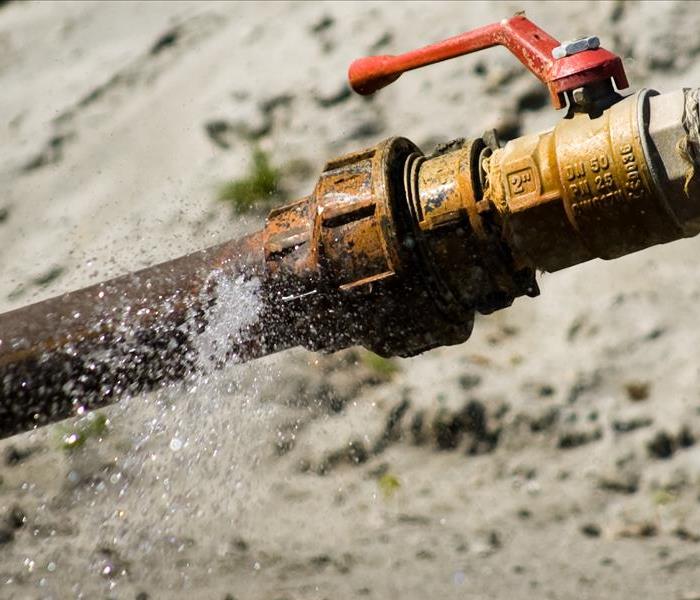 Leaky pipe.
Leaky pipe.
Stress on pipes can result in leaks which can be expensive to fix, replace and, not to mention, could cause extensive water damage to your home, business and personal items if they burst. Here are some ways to decrease the amount of stress and pressure on your pipes.
High water pressure can feel nice in the shower and it may seem like the dishes are getting done faster but, this can put an unnecessary amount of strain on your plumbing. You can get a hose bib gauge at your local hardware store to test the pressure. Attach it to an outside spigot and open the valve. Normal pressure is between 40-85 PSI so if you pressure measures above this, you may want to consider hiring a plumber to install a pressure reducer. You can also install a low flow shower head in your bathroom to help reduce pressure there.
Hard water is another obstacle as far as pipes are concerned. Hard water is water with a higher than normal amount of mineral content such as calcium or magnesium present. These minerals can build up inside your pipes which restricts flow and in turn, increases the pressure. Deposits can also corrode joints and fittings over time. If you see a white substance on our faucet heads, you more than likely have hard water. If you are unsure or want more proof, ask your local municipality to view the water quality report they are required to have through the Environmental Protection Agency. The only way to effectively soften the water in your home or business is by having a plumber install a water softener.
Wrap your pipes. If you have exterior piping and plan on going out of town in the winter months, take precautions to prevent coming home to a disaster. Wrap your pipes in electrical heat tape or a pipe sleeve which you can purchase at your local hardware store to prevent them from freezing. Remember, if the water is not constantly moving and the cold water pipes touch the exterior of the building when the temperature gets below freezing, your pipes will most likely freeze!
Set the spigot valve. If you have a pipe running through cement to your outside spigot valve, it’s always a good idea to install a frost-free hose bib which allows you to shut off water to the inside of the home preventing freezing.
These are all relatively simple and in expensive ways to protect your pipes that in the end could save you thousands of dollars!
What is the IICRC
1/18/2016 (Permalink)
 IICRC logo.
IICRC logo.
The IICRC stands for the Institute of Inspection Cleaning and Restoration Certification. They are a non-profit organization that sets the standards for the cleaning, installation, inspection and restoration industry for more than 25 countries. They offer classes, training and certification.
The IICRC was formed in 1972 by Ed York and was originally intended to be the standard for carpet and upholstery cleaning. Quickly, the organization grew to include water, fire and smoke damage, cleanup and repair, as well as wood, stone and tile cleaning and repair.
How Are the Certifications and Classes Determined?
IICRC’s Shareholders vote to nominate candidates to sit on a Board of Directors which is comprised of 15 industry professionals. The Board only meets four times of year so within the Board, there is an Executive Committee. The Committee is selected once a year at the fall meeting. The Board, along with the Committee, determines the direction of the organization while still following the ethics and guidelines set in place by IICRC. The Board determines what classes and certifications are necessary throughout the industry. The IICRC does not own schools or hire instructors but rather approves them to teach classes according to the organizations standards.
For more information on the IICRC, you can visit their website here: http://www.IICRC.org/
Different Types of Water Damage
1/14/2016 (Permalink)
Water Damage is split up into three different types of categories and four different types of classes according to the Institute of Cleaning and Restoration Certification (IICRC) which sets the industry standards for the water damage restoration and repair industry.
The following categories describe the type of water involved:
Category 1: This is water from a clean source such as faucets, toilets, tanks, drinking fountains, etc.
Category 2: Liquid in this category is sometimes called grey water. The level of contaminants in grey water may cause illness if ingested and comes from sources such as dishwasher or washing machines, sink drains and toilet overflows with some urine but no fecal matter.
Category 3: This is the most unsanitary classification as it could cause severe illness or even death if ingested. Liquid in this category is also known as black water and comes from sewer backup, flooding from rivers, streams, toilet overflow with fecal matter and stagnant liquid that has begun to grow bacteria.
The classes below describe the level of destruction.
Class 1: Only one area of the room was affected, little or no wet carpet, and water has only touched materials with a low permeance rate such as plywood or concrete. Evaporation rate is slow in this class and damage is the easiest to deal with.
Class 2: In this class, the evaporation rate is fast and water has affected the entire room, going up the wall at least a foot leaving a lot of moisture in materials.
Class 3: Liquid may have come from above and the ceilings, walls, insulation, carpet and sub-floors are all saturated and have the fastest evaporation rate.
Class 4: Specialty drying situations are placed in this class when there is enough water to completely saturate materials with very low permeance such as hardwood, brick or stone.
These categories and classes are used by the restoration industry to determine what type of plan and process should be used in each water damage situation. Ask your restoration company beforehand if their technicians are IICRC certified to ensure the highest quality and standards in the cleanup process of your home or business.
 SERVPRO offers advanced equipment to extract water and dry water damaged homes in Syracuse. "Like it never even happened."
SERVPRO offers advanced equipment to extract water and dry water damaged homes in Syracuse. "Like it never even happened."






 24/7 Emergency Service
24/7 Emergency Service

















